#Learn Pain Less's RSS Feed
Explore tagged Tumblr posts
Note
how do you keep up with all these articles and websites? With twitter being down the shitter, and tumblr recycling month old posts, i havent been able to find a good central news source. I figured I could use RSS feeds, but these sites post SOOOO frequently that I find it overwhelming. any advice?
it's an eclectic process. I watch some TV news which gives me a heads up on things happening. So does dreamwidth and tumblr and friends with different areas of interests that will let me know about things happening in the areas they watch or in their countries. I also watch a couple of other progressive aggregators with sort of Venn diagram interest areas with mine. So some stuff over laps with things I already read, but there are more things I wouldn't have spotted on my own that are important and/or interesting. I also have a bunch of searches I do for longer running things, and things I'll do a random periodic search on to check in with ongoing situations that mostly fell out of the English language news cycle.
I started out doing history articles and archeology news, that sort of thing. Then there was a little commentary. Then Us politics went completely berserk and I ran out of time to properly read and post breaking news, let alone the things i still care about but are so much less world on fire. I try to squeeze some in at the edges never theless.
It helps that I read stupid fast with a high comprehension rate. also, I'm disabled and don't work, so I have time other people don't have, even working at whatever pace my body is up for that day. I can just go lie down if need to. I don't have to force myself to type much if my arm is completely fucked that day. Most people have a whole lot of time sucked into working and commuting. Most aggregators are working to some sort of schedule if only self imposed.
A lot of why my out put rate is so uneven from day to day is some days I am too busy or ill. Some days I do a ton of reading and prepping, but am too ill or tired or in pain and can't post much of it. The massive output Sunday evening was an example of the opposite thing, where I hadn't time to read, but I had a ton of links read and preorganized, so I could toss them onto the dreamwith scaffold and post them very fast at the same time on Tumblr, so I gnawed through some of my backlog pile.
(I post a sorted aggregate on dreamwidth once or twice a week at https://gwydion.dreamwidth.org/. Tumblr they mostly go up in batches).
I am doing this on the most basic level out of love. I love learning stuff, hence my origins over on livejournal before the Russians got it, sharing links to articles about cool things people dug up. I grew up in a political family. I've been watching politics since the Ford/Carter debates. I do care about the world. I want things to be better. I can't march. I can signal boost, and write, and share links, and call politicians to complain about stuff. It means a lot to me when people I don't know look at what I do and it helps them in some way.
I would be reading news regardless. I learned at the age of eight that when confronted with horrors, that for me personally, I do best if I study the enemy. This allowed me to work out how best to resist and survive. all these decades later, my survival strategy dishes up news links organized in anxiety friendly ways on dreamwidth, and in the more chaotic but blacklistable form here on tumblr. I'm anal retentive about news tagging to help the people who aren't here for that or who aren't up to staring directly into the void with me and drinking from the news fire hose. I never even expect my closest friends to read all my output, because my volume is rather excessive.
Don't feel bad if you aren't up to it, some days or weeks or months. My adaptation is wildly atypical and for most people this would be unhealthy.
If the news is too much, it's okay to take a mental health break. I do ask that you vote, because we need everyone, regardless of country to save the world. The news will still be there when you are up to it
Any aggregate has a bias, both selection, and the other kind. there are things i don't cover because I don't know they are happening or because there isn't time. There are a whole lot of other things that I don't or barely cover because they aren't good for me. it is so much harder to see absence than presence.
My best advice to you, is to find someone like me who gets a lot of the things you are interested in so you can at least skim headlines. More than one is better, but if you get stressed out by the output keep it simple. Find some news sites you trust or if you have a good local paper get a subscription. (I used to read the paper everyday, but my local paper is extra bad, so I'm all online now). Read articles on things that interest you. If you are up to it do some searches on topics important to you.
Whatever you do, never read or watch one news source exclusively. Every source has biases. If all that history training has taught me anything, it's that.
Remember that no one can read everything and that's okay.
I have no idea if this helps. I just stopped to read your note before bed, so I'm a bit rambly.
7 notes
·
View notes
Text
#learn pain less#flutter login#learn pain less's rss feed#google flutter#flutter security#flutter#latest#latest tech
0 notes
Text
The Thirteenth Fourth
Well boy howdy. The 13th birthday of CSS-Tricks has rolled around. A proper teenager now, howabouthat? I always take the opportunity to do a bit of a state of the union address at this time, so let’s get to it!

Design
Technically, we’re still on v17 of the site design. This was the first design that I hired first-class help to do, and I’m still loving it, so I haven’t had much of an itch to do massive changes to it. Although it is quite different¹ today than it was on launch day.
For example…
The search experience is totally different, as it is powered by Jetpack’s Instant Search now.
The Almanac pages (e.g. background-blend-mode) have an additional sidebar that helps you navigate between pages
I re-did the typography using Hoefler&Co. Sentinel and Ringside. The monospace font code snippets are in Operator Mono and the logo has long-been Gotham Rounded, so it feels like one big happy family of typefaces.
Maybe next year we’ll do something different again. My list is starting to grow for some behind-the-scenes tech stuff I wanna re-jigger, and sometimes that goes hand in hand with redesign work.
Closed Forums
The forums on this site have been a mental weight on me for literally years. Earlier this year I finally turned them off. They are still there, and probably always will be (so the URLs are maintained), but nobody can post new threads or replies.
It was a painful move. Even as I did it, there was still some regular daily activity there and I’m sure it didn’t feel good to those people to have a place they have invested time in shut down. Here’s why I did it:
Nobody here, including me, checked in on the forums with any regularity. Unmoderated public forums on the internet are not acceptable to me.
The spam volume was going up. There were periods where most posts, even after the automatic spam blocking I get from Akismet, where spam that required manual removal. Even if we had a dedicated forums employee, that’s no fun, and since we didn’t, it was just a random job for me and I don’t need a time sink like that.
The forums represent a certain level of technical debt. They need to be updated. Their design needs to be functional in the context of this site. At one point I ripped out all custom styles and left it be the default theme, which was a good step toward reducing technical debt, but in the end it wasn’t enough.
I can handle some work and some technical debt, of course. But when you combine those things with the fact that the forums don’t contribute much to what I consider to be the success of the site. They don’t exactly drive page views or advertising demand. There isn’t really money to hire help specifically for the forums. But that’s a small part of it. I want this site to help people. I think we can do that best if we focus on publishing with as little divided attention as possible. I think there are places on the internet that are better for forum-like discourse.
Now that they’ve been off a number of months, I can report that the lifting of the mental weight feels very good to me and there has been little if any major negatives.
Social
Here’s another mental weight I lifted: I stopped hand-managing the Twitter account (@css). I still think it’s good that we have a Twitter account (and that we have that cool handle), but I just don’t spend any time on it directly like I used to.
In the past, I’d queue up special articles with commentary and graphics and stuff and make sure the days were full with a spread of what I thought would be interesting tweets about web design and development. That’s fine and all, but it began to feel like a job without a paycheck.
We don’t get (or seem to drive) a lot of traffic from Twitter. Google Analytics shows social media accounts for less than 1% of our traffic. Investing time in “growing” Twitter just doesn’t have enough of an upside for me. Not to mention the obvious: Twitter can be terribly toxic and mentally draining.
So now, all our posts to Twitter are automated through the Jetpack social media connection (we really use Jetpack for tons of stuff). We hit publish on the site and the article is auto-tweeted. So if you use Twitter like an RSS feed of sorts (just show me the news!), you got it.
The result? Our follower count goes up at the same rate it always did. Engagement there is the same, or higher, than it ever was. What a relief. Do ten times less work for the same benefit.
When I have the urge to share a link with commentary I use the same system we’ve always had here: I write it up as a link blog post instead. Now we’re getting even more benefit: long-term content building, which is good for the thing that we actually have on our side: SEO.
Someday we could improve things by hand-writing the auto-tweet text with a bit more joie de vivre, crediting the author more clearly, and, #stretchgoal, a custom or fancy-generated social media graphic.
Opened Up Design Possibilities
One aspect of this site that I’ve been happy with is the opportunity to do custom design on content. Here are some examples of that infrastructure.
On any given blog post, we can pick a template. Some of those templates are very specific. For example, my essay The Great Divide is a template all to itself.
In the code base, I have a PHP template and a CSS file that are entirely dedicated to that post. I think that’s a fine way to handle a post you want to give extra attention to, although the existence of those two files is a bit of technical debt.
I learned something in the creation of that particular essay: what I really need to open up the art direction/design possibility on a post is a simple, stripped-down template to start from. So that’s what we call a “Fancy Post” now, another template choice for any particular post. Fancy Posts have a hero image and a centered column for the content of the post. From there, we can use custom CSS to style things right within WordPress itself.
For example, my recent post on DX is styled as a Fancy Post with Custom CSS applied right within the block editor.
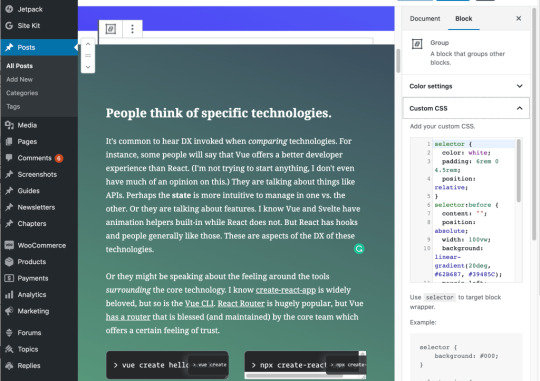

The Block Editor itself is a huge deal for us. That was one of my goals for the year, and we’ve really exceeded how far we’d get with it. I think writing and editing posts in the block editor is a million miles ahead of the old editor.
The hardest challenge was (and still is really) getting the block transforms set up for legacy content. But once you have the power to build and customize blocks, that alone opens up a ton of design possibility within posts that is too big of a pain in the butt and too heavy on technical debt otherwise.
Another door we opened for design possibilities is a classic one: using categories. A sort of freebie you get in WordPress is the ability to create templates for all sorts of things that just sort of automatically work if they are named correctly. So for example I have a file called category-2019-end-of-year-thoughts.php and that fully gives me control over making landing pages for groups of posts, like our end-of-year thoughts homepage. Not to mention our “Guide Collection” pages which are another way to programmatically build collections of pages.
That’s a lot of tools to do custom work with, and I’m really happy with that. It feels like we’ve given ourselves lots of potential with these tools, and only started taking advantage of it.
Speaking of which, another aspect of custom design we have available is the new book format…
eCommerce
We’re using WooCommerce here on the site now again. I just got done singing the praises of the Block Editor and how useful that has been… WooCommerce is in the same boat. I feel like I’m getting all this powerful functionality with very little effort, at a low cost, and with little technical debt. It makes me very happy to have this site on WordPress and using so much of suite of functionality that offers.
So for one thing, I can sell products with it, and we have products now! Lynn Fisher designed a poster for our CSS Flexbox guide and designed a poster for our CSS Grid guide, which you can now buy and ship anywhere in the world for $25 each. Look, with the Block Editor I can put a block for a poster right here in this post:
CSS Flexbox Poster
Find yourself constantly looking up the properties and values for CSS flexbox? Why not pin this beautiful poster up to the wall of your office so you can just glance over at it?
$25.00
Shop now
Another thing we’re using WooCommerce for is to sell our new book, The Greatest CSS Tricks Vol. I. If we actually made it into a proper eBook format, WooCommerce could absolutely deliver those files digitally to you, but we haven’t done that yet. We’ve take another path, which is publishing the book as chapters here on the site behind a membership paywall we’re calling MVP supporters. The book is just one of the benefits of that.
WooCommerce helps:
Build a membership system and sell memberships. Membership can lock certain pages to members-only as has programmatic hooks I can use for things like removing ads.
Sell subscriptions to those memberships, with recurring billing.
Sell one-off products
And I’m just scratching the surface of course. WooCommerce can do anything eCommerce wise.
Analytics
They are fine. Ha! That’s how much I worry about our general site analytics. I like to check in on them from time to time to make sure we’re not tanking or anything scary, but we never are (knock on wood). We’re in the vicinity of 8m page views a month, and year-over-year traffic is a bit of a dance.

Sponsors
THANK YOU THANK YOU THANK YOU
That’s what I have to say to all our sponsors. We’re so damn lucky to work with a lineup of sponsors that I wholeheartedly endorse as well as literally use their products. We have different sponsors all the time, but these are the biggest and those who have been with us the longest.
Automattic: Thanks for building great software for the WordPress ecosystem. This site is made possible by a heaping helping of that software.
Netlify: Thanks for bringing the Jamstack world to life. I’m also a big fan of this way of building websites, and think that Jamstack should be the foundation for most websites. Beyond that, you’ve redefined modern developer experience.
Flywheel: Thank you for hosting this website, being a high-quality host I can trust and who has been helpful to me countless times. This is what high-quality WordPress hosting looks like.
Frontend Masters: Thank you for being an education partner that does things right and helps me have the best possible answer for people when they are searching a more structured formal education about doing web work: go try Frontend Masters.
If you’re trying to reach front-end developers with your products, that’s literally how I make a living and can help.
My Other Projects
CodePen is no spring chicken either, being over 8 years old itself. I repeat myself a lot with this particular aspect of talking about CodePen: we’ve got a ton of ideas, a ton of work to do, and we can’t wait to show you the CodePen of tomorrow. 2020 for CodePen has been a lot different than the last 2-3 years of CodePen. Some technical choices we’ve made have been starting to pay off. The team is vibing very well and absolutely tearing through work faster than I would have thought possible a few years ago, and we haven’t even unlocked some of the biggest doors yet. I know that’s vague, but we talk in more detail about stuff on CodePen Radio.
ShopTalk, as ever, is going strong. That’s 420 episodes this week, friends. Dave has me convinced that our format as it is, is good. We aren’t an instruction manual. You don’t listen to any particular episode because we’re going to teach you some specific subject that we’ve explicitly listed out. It’s more like water cooler talk between real world developers who develop totally different things in totally different situations, but agree on more than we disagree. We might evolve what ShopTalk show is over time, but this format will live on because there is value in discussion in this format.
Life
My wife Miranda and I are still in Bend, Oregon and our Daughter Ruby is two and a half. She’s taking a nap and I’m looking at the monitor as I type.
We have the virus here like everywhere else. It’s sad to think that we’re this far into it and our local hospital is pleading with people to be careful this holiday weekend because they are very near capacity and can’t take much more. Here’s hoping we can get past this painful period. Stay safe and stay cool, friends, thanks for reading.
I always feel bad when I make design changes away from an actual professional designer’s work. Is the site design better today than Kylie‘s original? Uhm probably not (sorry for wrecking it Kylie!), but sometimes I just have an itch to fiddle with things and give things a fresh look. But the biggest driver of change is the evolving needs of the site and my desire to manage things with as little technical debt as possible, and sometimes simplifying design things helps me get there.
The post The Thirteenth Fourth appeared first on CSS-Tricks.
The Thirteenth Fourth published first on https://deskbysnafu.tumblr.com/
0 notes
Text
Why and how you should organize your curated content

You already know the impact curated content can have on your business. From marketing efforts to employee advocacy and hiring, content curation is a company’s superpower across the board.
But curated content is only useful if you can navigate your way through it.
Think about it. Would a talented fashion stylist do their job well if they couldn’t find the piece of clothing they needed in a wardrobe? Would a skilled accountant be efficient if they spent most of their time looking for the right spreadsheet or document?
The answer, of course, is a resounding no. The chaos in the assets you use and rely on every day will make it harder to see the results you want and hit long-term goals.
Great content curation depends on a system and structure you understand and can use with ease. In this guide, you’ll learn how well-organized curated content benefits your business, the structure that works best, and some ways you can achieve it with Scoop.it.
Why organizing your curated content is essential
Let’s go through a quick overview of why this process is worth going through.
Find what you need, even after curating hundreds or thousands of pieces
Let’s say you curate five pieces of content every workday. In a week, that’s 25 pieces. In a month, you’ll have about 100 of them, which is 1,200 for the year.
After a full year, will you be able to find the exact piece of content you need and you know you have since 10 months ago? The answer is probably no.
On top of that, if you curate more than those five pieces a day, and especially if you get other people and teams in your company involved in curation, you’ll easily end up with a lot more than just 100 curated pieces per month.
The sooner you create a structure for your curated content in place, the less of a challenge you’ll have down the road. Reaching the right piece of content will take only a few seconds and clicks, and no curated content will ever get lost.
Create a great experience for your reader
Think about how you consume content. One great post on a blog leads to another great post on the same blog. A helpful YouTube video from a creator leads to their other useful videos.
Well-structured, labeled, and organized content, regardless of the platform, makes it easy to absorb and enjoy that content. It creates a seamless flow from one piece to the other.
One of my favorite “start here” blog pages is the one from Orbit Media. One of the main reasons they were able to build such an easy-to-navigate list of their best blog posts is their effort to categorize every post they’ve published.
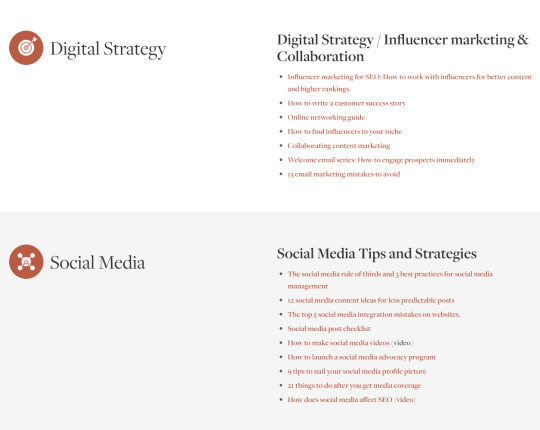
Your curated content should be no different. By assigning the right categories, topics, and tags to each piece you curate, your reader will be able to keep browsing through your curated content library and find exactly what they need.
Empower other teams
Curated content can be useful to everyone in your company. Think about it:
Sales team can reference it in their sales conversations (for example, when answering prospect’s questions or addressing a specific pain point)
Writers can use it to find relevant studies and examples to link to
Customer support team can use it to keep an eye on current industry trends around topics most important to your customers
Product development can reference it in brainstorming or problem-solving sessions
The options are endless, but the only way they can happen is if the structure of your curated content helps the right person get to the right topic quickly.
Hierarchy of your curated content
What is the right way to set up and organize your curated content so you can always find what you need quickly? Here’s a simple and effective structure you can start with.
High-level overview: Broad categories
First, define some broad categories that you typically cover in your content. There is no one-size-fits-all rule for this, but here are some starting points that can help. Your broad categories could reflect:
The categories you already use on your blog
Your product or service categories
The industries you serve
The teams in your company
Here are some examples for broad categories:
Law firm: data protection, employment law, healthcare, real estate
Marketing software: content marketing, social media, project management, email marketing
Web design agency: analytics, SEO, digital strategy, social media, web design, web development (this is exactly what earlier-mentioned Orbit uses as categories on their blog!)
Main focus: Core topics
Your topics are the center of your content curation strategy. They are the root of all the content that you curate.
Your curation workflow will be based on topics. In other words, when you find a fresh piece of content to curate, you’ll choose a topic to add it to.
Here are examples of topics based on some broad categories we listed earlier:
Employment law: legal tips for startups, workplace safety, contracts and procurement
Content marketing: content writing, content editing, creativity, content strategy
Analytics: Google Analytics, Google Tag manager, social media analytics
Detailed segmentation: Tags
Finally, you can further refine and label each piece of content you curate with tags. How you set up your tags is entirely up to you.
For example, you could use them as further branching of a topic into subtopics: creativity could have subtopics such as personal creativity, team creativity, psychology, leadership.
Another way to use tags is to label the format of each piece. This means your tags could be: article, video, webinar, podcast, PDF, research report, book. This also means that you could use the same set of tags across different topics and get used to the same segmentation in each of your topics.
Of course, you can experiment with different options and stick with the one that works best.
How to organize your curated content with Scoop.it
In sections that follow, we’ll show you how you can build your content curation structure from the ground up in Scoop.it.
Topics as the core of content curation
As we mentioned, topics are the foundation of efficient content curation efforts, and the same applies to how Scoop.it works.
To create a topic, you click the Create a Topic button from your dashboard. Then, you name it, make sure you’re happy with the topic URL, select a language, and confirm.
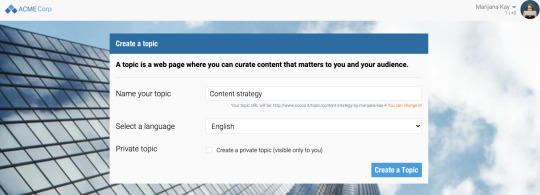
Topic customization
At the top of your new topic, you’ll see topic settings. This space will let you fully customize your topic.
Here are the options you’ll be able to tweak from the menu on the left-hand side:
Edit: title, language, description, user permissions for sharing and commenting
Sharing: connect your Twitter, LinkedIn, Facebook, Buffer, Pinterest, Yammer, or Tumblr account
Customization: change visual settings like images, layout, fonts, and colors for any element of your topic page
Automatic content import: set up RSS feeds and/or sitemaps
Teams: add authorized curators
Private: make your topic public to everyone, just your company, only you, selected users only, or make it password-protected
Lead generation: set up a lead generation form or integrate with Mailchimp
Topic group: add or remove your topic from topic groups
Topic groups
Once you’ve created all your topics, you can start grouping them into high-level groupings—broad categories.
In Scoop.it, these are called topic groups. To set them up, go to your company settings and choose Topic Groups from the left-hand side menu. Then, add the group and name it.
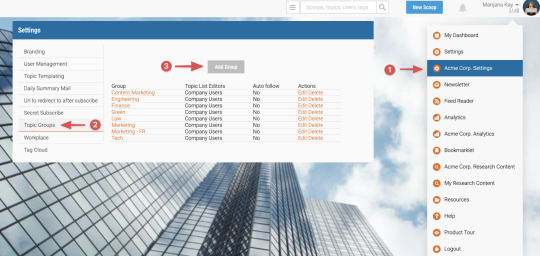
When you’re done, you can start adding topics to this broad category. For example, we could add our previously created content strategy topic to the content marketing category.
Use the search bar in the topic group settings to add your topics to it.
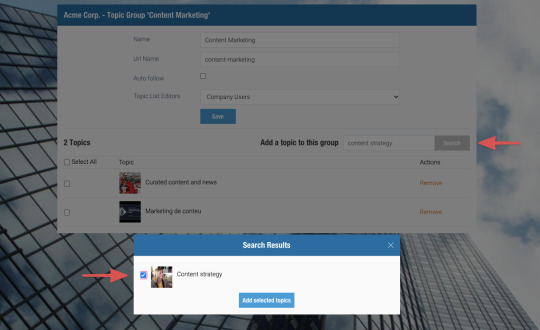
You can also set up the editors of this group to either company users or admin only.
Once you’ve created your topic groups and added relevant topics to them, you can easily access them from the three-line menu icon at the top bar of any page of your Scoop.it:

Tags
We started with topics, our content curation core. We then grouped them into larger categories. Finally, we can further segment our curated pieces and get specific thanks to tags.
Tags will let you easily navigate a topic and quickly get to the formats or subtopics you’re looking for. The best thing about them is that you can add them in a couple of seconds. It’s no extra work, but it still saves you time in the long run when you’re using these pieces later on.
When you curate a new piece of content to a topic, you’ll see this modal window that lets you add your insights and edit title and description. At the bottom, there’s a field to enter tags.
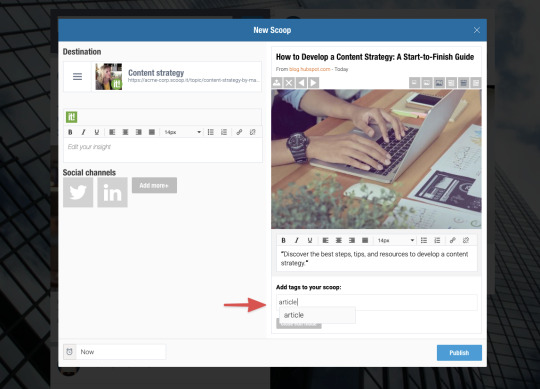
When you don’t have any tags, you can add them by typing in a tag name you want to create. After that, your tags will populate when you start typing so you can easily select them.
You can also add or remove tags after curating your content by clicking the tag icon at the bottom of each curated piece.
From here, your tags become the most powerful when you add them to the top of your topic page for easy access.
Click the funnel icon at the top right corner and click Add tag list as first Scoop.
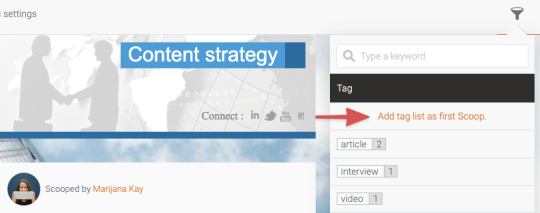
This creates clickable tags you can use to filter content on a topic page. This is how these tags will look like on the page:
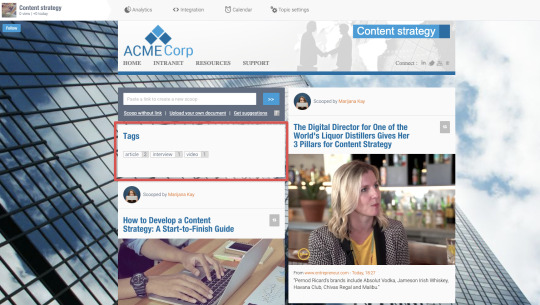
The more you curate and tag, the more impactful this section becomes. Remember the benefits of easy navigation through curated pieces, both for you and the rest of your company—a couple of seconds to add a tag are worth the effort!
If you want to see all the content with a specific tag (across all topics), instead of going to a topic page and filtering by tag, you can type in your tag in the search bar at the top. You’ll then see the option to click on a tag to view all company-wide content that has that tag:

Starred content
Finally, there’s a simple way to highlight a piece of content that’s currently most relevant: starring your content.
You’ll see the option to star a piece of content below it, alongside the sharing and tagging icons. When you click the star, that piece of content moves to the top spot on your topic page and stays there until you either unstar it or star a different piece.

This feature is great for bringing attention to a most relevant trend, report, or educational piece of content on a certain topic, and doing so quickly for everyone in your team and company.
Master your curated content organization and structure
With these tools and tips, you can easily access your entire curated content history and find the right piece of content within moments.
There’s no more need for frustration or time wasted on searching through hundreds (or thousands!) of pieces of content you’ve so carefully curated. Instead, you can focus on all the benefits that curated content can give you.
Want to see how this can work for you and your company? Get your Scoop.it Enterprise demo and take your content curation to the next level.

The post Why and how you should organize your curated content appeared first on Scoop.it Blog.
Why and how you should organize your curated content published first on https://wabusinessapi.tumblr.com/
0 notes
Text
Why and how you should organize your curated content

You already know the impact curated content can have on your business. From marketing efforts to employee advocacy and hiring, content curation is a company’s superpower across the board.
But curated content is only useful if you can navigate your way through it.
Think about it. Would a talented fashion stylist do their job well if they couldn’t find the piece of clothing they needed in a wardrobe? Would a skilled accountant be efficient if they spent most of their time looking for the right spreadsheet or document?
The answer, of course, is a resounding no. The chaos in the assets you use and rely on every day will make it harder to see the results you want and hit long-term goals.
Great content curation depends on a system and structure you understand and can use with ease. In this guide, you’ll learn how well-organized curated content benefits your business, the structure that works best, and some ways you can achieve it with Scoop.it.
Why organizing your curated content is essential
Let’s go through a quick overview of why this process is worth going through.
Find what you need, even after curating hundreds or thousands of pieces
Let’s say you curate five pieces of content every workday. In a week, that’s 25 pieces. In a month, you’ll have about 100 of them, which is 1,200 for the year.
After a full year, will you be able to find the exact piece of content you need and you know you have since 10 months ago? The answer is probably no.
On top of that, if you curate more than those five pieces a day, and especially if you get other people and teams in your company involved in curation, you’ll easily end up with a lot more than just 100 curated pieces per month.
The sooner you create a structure for your curated content in place, the less of a challenge you’ll have down the road. Reaching the right piece of content will take only a few seconds and clicks, and no curated content will ever get lost.
Create a great experience for your reader
Think about how you consume content. One great post on a blog leads to another great post on the same blog. A helpful YouTube video from a creator leads to their other useful videos.
Well-structured, labeled, and organized content, regardless of the platform, makes it easy to absorb and enjoy that content. It creates a seamless flow from one piece to the other.
One of my favorite “start here” blog pages is the one from Orbit Media. One of the main reasons they were able to build such an easy-to-navigate list of their best blog posts is their effort to categorize every post they’ve published.
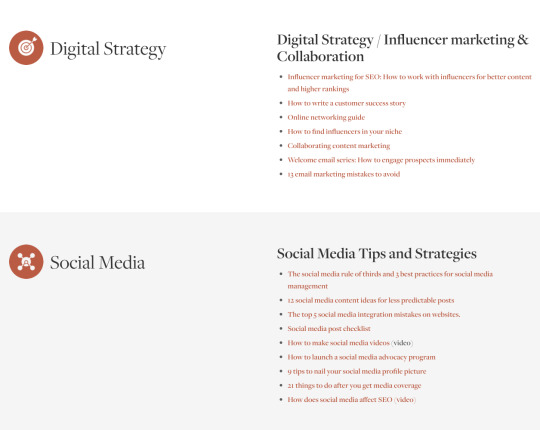
Your curated content should be no different. By assigning the right categories, topics, and tags to each piece you curate, your reader will be able to keep browsing through your curated content library and find exactly what they need.
Empower other teams
Curated content can be useful to everyone in your company. Think about it:
Sales team can reference it in their sales conversations (for example, when answering prospect’s questions or addressing a specific pain point)
Writers can use it to find relevant studies and examples to link to
Customer support team can use it to keep an eye on current industry trends around topics most important to your customers
Product development can reference it in brainstorming or problem-solving sessions
The options are endless, but the only way they can happen is if the structure of your curated content helps the right person get to the right topic quickly.
Hierarchy of your curated content
What is the right way to set up and organize your curated content so you can always find what you need quickly? Here’s a simple and effective structure you can start with.
High-level overview: Broad categories
First, define some broad categories that you typically cover in your content. There is no one-size-fits-all rule for this, but here are some starting points that can help. Your broad categories could reflect:
The categories you already use on your blog
Your product or service categories
The industries you serve
The teams in your company
Here are some examples for broad categories:
Law firm: data protection, employment law, healthcare, real estate
Marketing software: content marketing, social media, project management, email marketing
Web design agency: analytics, SEO, digital strategy, social media, web design, web development (this is exactly what earlier-mentioned Orbit uses as categories on their blog!)
Main focus: Core topics
Your topics are the center of your content curation strategy. They are the root of all the content that you curate.
Your curation workflow will be based on topics. In other words, when you find a fresh piece of content to curate, you’ll choose a topic to add it to.
Here are examples of topics based on some broad categories we listed earlier:
Employment law: legal tips for startups, workplace safety, contracts and procurement
Content marketing: content writing, content editing, creativity, content strategy
Analytics: Google Analytics, Google Tag manager, social media analytics
Detailed segmentation: Tags
Finally, you can further refine and label each piece of content you curate with tags. How you set up your tags is entirely up to you.
For example, you could use them as further branching of a topic into subtopics: creativity could have subtopics such as personal creativity, team creativity, psychology, leadership.
Another way to use tags is to label the format of each piece. This means your tags could be: article, video, webinar, podcast, PDF, research report, book. This also means that you could use the same set of tags across different topics and get used to the same segmentation in each of your topics.
Of course, you can experiment with different options and stick with the one that works best.
How to organize your curated content with Scoop.it
In sections that follow, we’ll show you how you can build your content curation structure from the ground up in Scoop.it.
Topics as the core of content curation
As we mentioned, topics are the foundation of efficient content curation efforts, and the same applies to how Scoop.it works.
To create a topic, you click the Create a Topic button from your dashboard. Then, you name it, make sure you’re happy with the topic URL, select a language, and confirm.
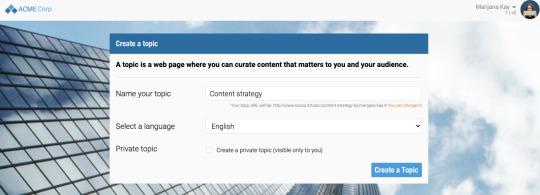
Topic customization
At the top of your new topic, you’ll see topic settings. This space will let you fully customize your topic.
Here are the options you’ll be able to tweak from the menu on the left-hand side:
Edit: title, language, description, user permissions for sharing and commenting
Sharing: connect your Twitter, LinkedIn, Facebook, Buffer, Pinterest, Yammer, or Tumblr account
Customization: change visual settings like images, layout, fonts, and colors for any element of your topic page
Automatic content import: set up RSS feeds and/or sitemaps
Teams: add authorized curators
Private: make your topic public to everyone, just your company, only you, selected users only, or make it password-protected
Lead generation: set up a lead generation form or integrate with Mailchimp
Topic group: add or remove your topic from topic groups
Topic groups
Once you’ve created all your topics, you can start grouping them into high-level groupings—broad categories.
In Scoop.it, these are called topic groups. To set them up, go to your company settings and choose Topic Groups from the left-hand side menu. Then, add the group and name it.
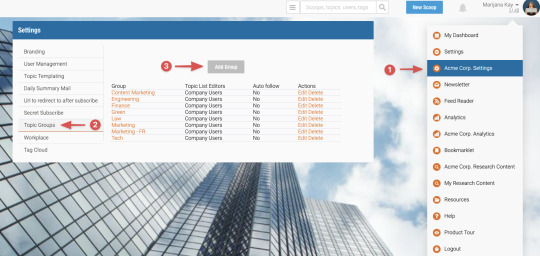
When you’re done, you can start adding topics to this broad category. For example, we could add our previously created content strategy topic to the content marketing category.
Use the search bar in the topic group settings to add your topics to it.
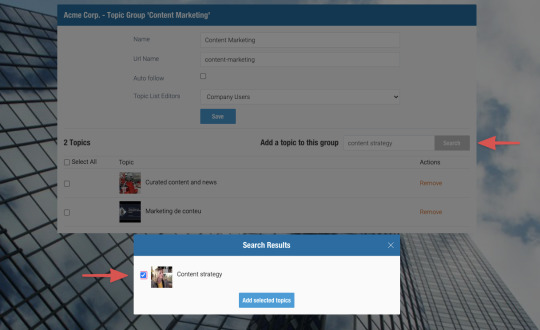
You can also set up the editors of this group to either company users or admin only.
Once you’ve created your topic groups and added relevant topics to them, you can easily access them from the three-line menu icon at the top bar of any page of your Scoop.it:
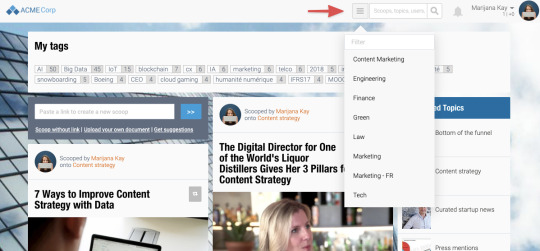
Tags
We started with topics, our content curation core. We then grouped them into larger categories. Finally, we can further segment our curated pieces and get specific thanks to tags.
Tags will let you easily navigate a topic and quickly get to the formats or subtopics you’re looking for. The best thing about them is that you can add them in a couple of seconds. It’s no extra work, but it still saves you time in the long run when you’re using these pieces later on.
When you curate a new piece of content to a topic, you’ll see this modal window that lets you add your insights and edit title and description. At the bottom, there’s a field to enter tags.
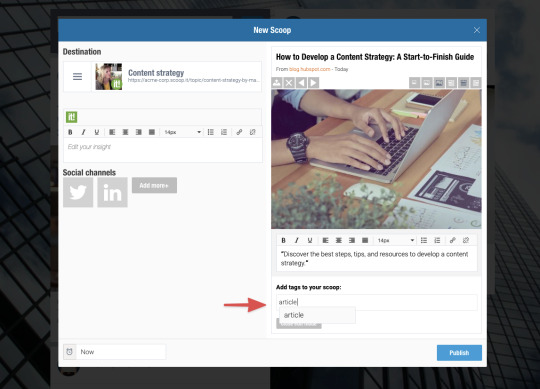
When you don’t have any tags, you can add them by typing in a tag name you want to create. After that, your tags will populate when you start typing so you can easily select them.
You can also add or remove tags after curating your content by clicking the tag icon at the bottom of each curated piece.
From here, your tags become the most powerful when you add them to the top of your topic page for easy access.
Click the funnel icon at the top right corner and click Add tag list as first Scoop.
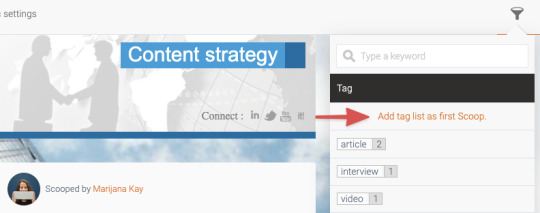
This creates clickable tags you can use to filter content on a topic page. This is how these tags will look like on the page:
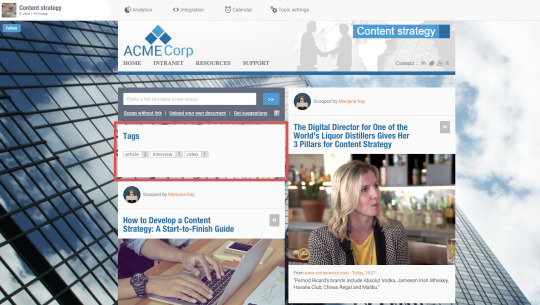
The more you curate and tag, the more impactful this section becomes. Remember the benefits of easy navigation through curated pieces, both for you and the rest of your company—a couple of seconds to add a tag are worth the effort!
If you want to see all the content with a specific tag (across all topics), instead of going to a topic page and filtering by tag, you can type in your tag in the search bar at the top. You’ll then see the option to click on a tag to view all company-wide content that has that tag:

Starred content
Finally, there’s a simple way to highlight a piece of content that’s currently most relevant: starring your content.
You’ll see the option to star a piece of content below it, alongside the sharing and tagging icons. When you click the star, that piece of content moves to the top spot on your topic page and stays there until you either unstar it or star a different piece.

This feature is great for bringing attention to a most relevant trend, report, or educational piece of content on a certain topic, and doing so quickly for everyone in your team and company.
Master your curated content organization and structure
With these tools and tips, you can easily access your entire curated content history and find the right piece of content within moments.
There’s no more need for frustration or time wasted on searching through hundreds (or thousands!) of pieces of content you’ve so carefully curated. Instead, you can focus on all the benefits that curated content can give you.
Want to see how this can work for you and your company? Get your Scoop.it Enterprise demo and take your content curation to the next level.

The post Why and how you should organize your curated content appeared first on Scoop.it Blog.
Why and how you should organize your curated content published first on https://improfitninja.weebly.com/
0 notes
Text
10 Lessons From Dalai Lama That Will Change Your Life
10 Lessons From Dalai Lama That Will Change Your Life
“Be kind when possible.” And maybe it’s always. ”
Once Oprah Winfrey asked the Dalai Lama: “Have you had to forgive yourself for something?” His Holiness replied: “To be honest, my attitude to mosquitoes was not very friendly and calm, as, in fact, to bedbugs.”

10 Lessons From Dalai Lama That Will Change Your Life
Lessons From Dalai Lama
Oprah was incredibly surprised that for the 78 years the Dalai Lama lived at that time, he did nothing else, which, in his opinion, would be forgiven. Forgiveness and compassion for all living beings have always been the two cornerstones of the teachings of the Dalai Lama. So let’s find out how his lessons can change our whole life, if only we let them do it.
1. Show more empathy.
“Compassion and compassion has nothing to do with religion as such. But it has the most direct relation to humanity. Moreover, without them, the survival of mankind would have been impossible. ”- The Dalai Lama
The results of many studies show that when you show sympathy for other people, you experience the same burst of energy and good mood as when you have sex, eat something tasty, or, say, relax in a hot bath. Simply put, empathy is good for your health. So show sympathy for your neighbor and get all the wonderful benefits: reducing stress, normalizing heart rate and improving immunity.
How to show empathy for another person? To do this, you just need to try to understand his feelings and emotions. Talk to him and try to understand what he has to go through. This is a much more demanding process for you than just showing kindness. If you want to show empathy, you cannot do without emotional involvement. By the way, at the same time, you can ask about what kind of help your interlocutor needs. You can apply this to:
Sick friend
Someone who has lost their job and really needs support
To a relative who does not know what to do with his life
To a friend who has just survived a painful breakup
The homeless
2. Be kind and help other people. – Lessons From Dalai Lama
“My faith is very simple. She does not need temples or scripture. Our own mind, our heart, must become a temple, and kindness must become our scripture. Be kind when possible. And maybe it’s always, ”the Dalai Lama.
In fact, kindness and generosity cost you not so much, but thanks to them you can become much happier. This is the conclusion Michael Norton and his colleagues at the Harvard Business School came from after a rather curious scientific study.
As it turned out, volunteers who, having received a certain amount, donated part of it to those in need, were invariably happier than those who spent everything only on themselves.
3. Find your happiness.
“The meaning of our life is to be happy”
Dalai Lama
Sometimes our life becomes so hectic and messy that the only thing we want at the end of the next day is the opportunity to be at least a little happy.
When the Dalai Lama was asked about happiness, he replied that modern society is literally overwhelming us with messages about material wealth. And that we see very few messages about forgiveness, sympathy, patience, goodwill and kindness.
But in order to be truly happy, you must devote more time to these values, and not to the accumulation of material wealth.
“No one is able to give us happiness ready — it always stems from our own actions”
Dalai Lama
4. Find peace in the depths of your own soul. – Lessons From Dalai Lama
The Dalai Lama advises every day to spend at least a little time alone with themselves. Spend this time thinking about your own life and the fact that you don’t need negative thoughts like anger, contempt, hatred and envy. Try to replace them with positive emotions such as optimism, gratitude, love, and calm.
The Dalai Lama believes that only a truly calm and peaceful mind can become a source of happiness and good health, and in this he is absolutely right.
5. Do no harm to other people.
“If you can help others, do it, if you cannot, then at least do not harm them”
Dalai Lama
If you suddenly begin to “feed” other people with outright lies, spread vile rumors about them, achieve the desired threats and take advantage of the unfair advantage over them, then the negative “return” from all this will sooner or later poison your life, depriving any hope of happiness.
These are just a few actions that can harm others, but try to avoid both them and all of their ilk.
6. Take care of your friendships.
Friendship is the most wonderful thing that can happen to you. Take care of your friends and never offend them – and in return they will generously endow you with trust and affection. True friendship never depends on your position in society or how much money you have.
It is a pity that many people neglect friends so much that as a result, loneliness begins to rule their life. Not surprisingly, all this leads to depression.
7. Do not let modern technology manage your life.
Did you know that the Dalai Lama has over 8 million followers on Twitter? And although he welcomes the ease with which social networks allow us to communicate with each other, he also warns against the excessive use of modern technologies, citing the following arguments:
Sometimes they penetrate our lives so much that they begin to control it – look at least at the couples in restaurants that spend all their time burying themselves on the screens of their phones.
If you cannot even spend a day without your phone, who is in charge of your pair – you or he?
Even if you have a lot of virtual friends, they will not necessarily be able to replace true friendship.
Virtual communication very rarely helps you show empathy for others.
If you spend almost all your time communicating online, you will have much less time communicating in reality.
“Technology is our brainchild, and we must control it. If we become slaves of technology, this in no way will benefit us”
Dalai Lama
8. Do not quarrel or argue – it is better to negotiate.
“The path of non-violence means the path of communication and dialogue, which are conducted in words, not fists. Dialogues mean compromise and respect for each other’s rights: only communication and reconciliation can reliably save us from conflicts and disappointments. When both sides meet each other, in the end, there are neither 100% winners nor losers. This is the wisest way to resolve conflicts. The only sure way. ”- The Dalai Lama
No matter what kind of conflict you have to deal with, be it an international crisis or a quarrel with your partner or boss, dialogue is always the key to the most peaceful and calm outcome. Only in this way can you learn the art of compromise and negotiation.
His Holiness advises during the dialogue to recall the past as little as possible, instead focusing on what caused the current problem.
9. Be kind to the earth. – Lessons From Dalai Lama
If we want the human race to survive, it is important to take care of this planet as well as we can. Give garbage for recycling, look at alternative ways to get energy and find out exactly how you can help save nature so that it does not want to recoup on humanity as a whole.
10. Learn from your mistakes. – Lessons From Dalai Lama
“If you lost, but learned a valuable lesson, then you won”
Dalai Lama
When you make a mistake, take a look at what happened with a sober look, and try to understand what went wrong and when. Perhaps you said something wrong or did not think enough of your actions.
Perhaps a mistake has crept into your project at the design stage, and maybe you did not take into account force majeure situations. Even if you encounter a catastrophe and are forced to collect life in pieces after it, you can still extract something useful from it.
The post 10 Lessons From Dalai Lama That Will Change Your Life appeared first on ToLoveForward.
from https://toloveforward.com/10-lessons-from-dalai-lama-that-will-change-your-life/?utm_source=rss&utm_medium=rss&utm_campaign=10-lessons-from-dalai-lama-that-will-change-your-life
from TOLOVEFORWARD - Blog https://toloveforward.weebly.com/blog/10-lessons-from-dalai-lama-that-will-change-your-life
0 notes
Text
10 Lessons From Dalai Lama That Will Change Your Life
10 Lessons From Dalai Lama That Will Change Your Life
“Be kind when possible.” And maybe it’s always. ”
Once Oprah Winfrey asked the Dalai Lama: “Have you had to forgive yourself for something?” His Holiness replied: “To be honest, my attitude to mosquitoes was not very friendly and calm, as, in fact, to bedbugs.”

10 Lessons From Dalai Lama That Will Change Your Life
Lessons From Dalai Lama
Oprah was incredibly surprised that for the 78 years the Dalai Lama lived at that time, he did nothing else, which, in his opinion, would be forgiven. Forgiveness and compassion for all living beings have always been the two cornerstones of the teachings of the Dalai Lama. So let’s find out how his lessons can change our whole life, if only we let them do it.
1. Show more empathy.
“Compassion and compassion has nothing to do with religion as such. But it has the most direct relation to humanity. Moreover, without them, the survival of mankind would have been impossible. ”- The Dalai Lama
The results of many studies show that when you show sympathy for other people, you experience the same burst of energy and good mood as when you have sex, eat something tasty, or, say, relax in a hot bath. Simply put, empathy is good for your health. So show sympathy for your neighbor and get all the wonderful benefits: reducing stress, normalizing heart rate and improving immunity.
How to show empathy for another person? To do this, you just need to try to understand his feelings and emotions. Talk to him and try to understand what he has to go through. This is a much more demanding process for you than just showing kindness. If you want to show empathy, you cannot do without emotional involvement. By the way, at the same time, you can ask about what kind of help your interlocutor needs. You can apply this to:
Sick friend
Someone who has lost their job and really needs support
To a relative who does not know what to do with his life
To a friend who has just survived a painful breakup
The homeless
2. Be kind and help other people. – Lessons From Dalai Lama
“My faith is very simple. She does not need temples or scripture. Our own mind, our heart, must become a temple, and kindness must become our scripture. Be kind when possible. And maybe it’s always, ”the Dalai Lama.
In fact, kindness and generosity cost you not so much, but thanks to them you can become much happier. This is the conclusion Michael Norton and his colleagues at the Harvard Business School came from after a rather curious scientific study.
As it turned out, volunteers who, having received a certain amount, donated part of it to those in need, were invariably happier than those who spent everything only on themselves.
3. Find your happiness.
“The meaning of our life is to be happy”
Dalai Lama
Sometimes our life becomes so hectic and messy that the only thing we want at the end of the next day is the opportunity to be at least a little happy.
When the Dalai Lama was asked about happiness, he replied that modern society is literally overwhelming us with messages about material wealth. And that we see very few messages about forgiveness, sympathy, patience, goodwill and kindness.
But in order to be truly happy, you must devote more time to these values, and not to the accumulation of material wealth.
“No one is able to give us happiness ready — it always stems from our own actions”
Dalai Lama
4. Find peace in the depths of your own soul. – Lessons From Dalai Lama
The Dalai Lama advises every day to spend at least a little time alone with themselves. Spend this time thinking about your own life and the fact that you don’t need negative thoughts like anger, contempt, hatred and envy. Try to replace them with positive emotions such as optimism, gratitude, love, and calm.
The Dalai Lama believes that only a truly calm and peaceful mind can become a source of happiness and good health, and in this he is absolutely right.
5. Do no harm to other people.
“If you can help others, do it, if you cannot, then at least do not harm them”
Dalai Lama
If you suddenly begin to “feed” other people with outright lies, spread vile rumors about them, achieve the desired threats and take advantage of the unfair advantage over them, then the negative “return” from all this will sooner or later poison your life, depriving any hope of happiness.
These are just a few actions that can harm others, but try to avoid both them and all of their ilk.
6. Take care of your friendships.
Friendship is the most wonderful thing that can happen to you. Take care of your friends and never offend them – and in return they will generously endow you with trust and affection. True friendship never depends on your position in society or how much money you have.
It is a pity that many people neglect friends so much that as a result, loneliness begins to rule their life. Not surprisingly, all this leads to depression.
7. Do not let modern technology manage your life.
Did you know that the Dalai Lama has over 8 million followers on Twitter? And although he welcomes the ease with which social networks allow us to communicate with each other, he also warns against the excessive use of modern technologies, citing the following arguments:
Sometimes they penetrate our lives so much that they begin to control it – look at least at the couples in restaurants that spend all their time burying themselves on the screens of their phones.
If you cannot even spend a day without your phone, who is in charge of your pair – you or he?
Even if you have a lot of virtual friends, they will not necessarily be able to replace true friendship.
Virtual communication very rarely helps you show empathy for others.
If you spend almost all your time communicating online, you will have much less time communicating in reality.
“Technology is our brainchild, and we must control it. If we become slaves of technology, this in no way will benefit us”
Dalai Lama
8. Do not quarrel or argue – it is better to negotiate.
“The path of non-violence means the path of communication and dialogue, which are conducted in words, not fists. Dialogues mean compromise and respect for each other’s rights: only communication and reconciliation can reliably save us from conflicts and disappointments. When both sides meet each other, in the end, there are neither 100% winners nor losers. This is the wisest way to resolve conflicts. The only sure way. ”- The Dalai Lama
No matter what kind of conflict you have to deal with, be it an international crisis or a quarrel with your partner or boss, dialogue is always the key to the most peaceful and calm outcome. Only in this way can you learn the art of compromise and negotiation.
His Holiness advises during the dialogue to recall the past as little as possible, instead focusing on what caused the current problem.
9. Be kind to the earth. – Lessons From Dalai Lama
If we want the human race to survive, it is important to take care of this planet as well as we can. Give garbage for recycling, look at alternative ways to get energy and find out exactly how you can help save nature so that it does not want to recoup on humanity as a whole.
10. Learn from your mistakes. – Lessons From Dalai Lama
“If you lost, but learned a valuable lesson, then you won”
Dalai Lama
When you make a mistake, take a look at what happened with a sober look, and try to understand what went wrong and when. Perhaps you said something wrong or did not think enough of your actions.
Perhaps a mistake has crept into your project at the design stage, and maybe you did not take into account force majeure situations. Even if you encounter a catastrophe and are forced to collect life in pieces after it, you can still extract something useful from it.
The post 10 Lessons From Dalai Lama That Will Change Your Life appeared first on ToLoveForward.
from ToLoveForward https://toloveforward.com/10-lessons-from-dalai-lama-that-will-change-your-life/?utm_source=rss&utm_medium=rss&utm_campaign=10-lessons-from-dalai-lama-that-will-change-your-life from TOLOVEFORWARD https://toloveforward.tumblr.com/post/622365096474263552
0 notes
Text
10 Lessons From Dalai Lama That Will Change Your Life
10 Lessons From Dalai Lama That Will Change Your Life
“Be kind when possible.” And maybe it’s always. ”
Once Oprah Winfrey asked the Dalai Lama: “Have you had to forgive yourself for something?” His Holiness replied: “To be honest, my attitude to mosquitoes was not very friendly and calm, as, in fact, to bedbugs.”

10 Lessons From Dalai Lama That Will Change Your Life
Lessons From Dalai Lama
Oprah was incredibly surprised that for the 78 years the Dalai Lama lived at that time, he did nothing else, which, in his opinion, would be forgiven. Forgiveness and compassion for all living beings have always been the two cornerstones of the teachings of the Dalai Lama. So let’s find out how his lessons can change our whole life, if only we let them do it.
1. Show more empathy.
“Compassion and compassion has nothing to do with religion as such. But it has the most direct relation to humanity. Moreover, without them, the survival of mankind would have been impossible. ”- The Dalai Lama
The results of many studies show that when you show sympathy for other people, you experience the same burst of energy and good mood as when you have sex, eat something tasty, or, say, relax in a hot bath. Simply put, empathy is good for your health. So show sympathy for your neighbor and get all the wonderful benefits: reducing stress, normalizing heart rate and improving immunity.
How to show empathy for another person? To do this, you just need to try to understand his feelings and emotions. Talk to him and try to understand what he has to go through. This is a much more demanding process for you than just showing kindness. If you want to show empathy, you cannot do without emotional involvement. By the way, at the same time, you can ask about what kind of help your interlocutor needs. You can apply this to:
Sick friend
Someone who has lost their job and really needs support
To a relative who does not know what to do with his life
To a friend who has just survived a painful breakup
The homeless
2. Be kind and help other people. – Lessons From Dalai Lama
“My faith is very simple. She does not need temples or scripture. Our own mind, our heart, must become a temple, and kindness must become our scripture. Be kind when possible. And maybe it’s always, ”the Dalai Lama.
In fact, kindness and generosity cost you not so much, but thanks to them you can become much happier. This is the conclusion Michael Norton and his colleagues at the Harvard Business School came from after a rather curious scientific study.
As it turned out, volunteers who, having received a certain amount, donated part of it to those in need, were invariably happier than those who spent everything only on themselves.
3. Find your happiness.
“The meaning of our life is to be happy”
Dalai Lama
Sometimes our life becomes so hectic and messy that the only thing we want at the end of the next day is the opportunity to be at least a little happy.
When the Dalai Lama was asked about happiness, he replied that modern society is literally overwhelming us with messages about material wealth. And that we see very few messages about forgiveness, sympathy, patience, goodwill and kindness.
But in order to be truly happy, you must devote more time to these values, and not to the accumulation of material wealth.
“No one is able to give us happiness ready — it always stems from our own actions”
Dalai Lama
4. Find peace in the depths of your own soul. – Lessons From Dalai Lama
The Dalai Lama advises every day to spend at least a little time alone with themselves. Spend this time thinking about your own life and the fact that you don’t need negative thoughts like anger, contempt, hatred and envy. Try to replace them with positive emotions such as optimism, gratitude, love, and calm.
The Dalai Lama believes that only a truly calm and peaceful mind can become a source of happiness and good health, and in this he is absolutely right.
5. Do no harm to other people.
“If you can help others, do it, if you cannot, then at least do not harm them”
Dalai Lama
If you suddenly begin to “feed” other people with outright lies, spread vile rumors about them, achieve the desired threats and take advantage of the unfair advantage over them, then the negative “return” from all this will sooner or later poison your life, depriving any hope of happiness.
These are just a few actions that can harm others, but try to avoid both them and all of their ilk.
6. Take care of your friendships.
Friendship is the most wonderful thing that can happen to you. Take care of your friends and never offend them – and in return they will generously endow you with trust and affection. True friendship never depends on your position in society or how much money you have.
It is a pity that many people neglect friends so much that as a result, loneliness begins to rule their life. Not surprisingly, all this leads to depression.
7. Do not let modern technology manage your life.
Did you know that the Dalai Lama has over 8 million followers on Twitter? And although he welcomes the ease with which social networks allow us to communicate with each other, he also warns against the excessive use of modern technologies, citing the following arguments:
Sometimes they penetrate our lives so much that they begin to control it – look at least at the couples in restaurants that spend all their time burying themselves on the screens of their phones.
If you cannot even spend a day without your phone, who is in charge of your pair – you or he?
Even if you have a lot of virtual friends, they will not necessarily be able to replace true friendship.
Virtual communication very rarely helps you show empathy for others.
If you spend almost all your time communicating online, you will have much less time communicating in reality.
“Technology is our brainchild, and we must control it. If we become slaves of technology, this in no way will benefit us”
Dalai Lama
8. Do not quarrel or argue – it is better to negotiate.
“The path of non-violence means the path of communication and dialogue, which are conducted in words, not fists. Dialogues mean compromise and respect for each other’s rights: only communication and reconciliation can reliably save us from conflicts and disappointments. When both sides meet each other, in the end, there are neither 100% winners nor losers. This is the wisest way to resolve conflicts. The only sure way. ”- The Dalai Lama
No matter what kind of conflict you have to deal with, be it an international crisis or a quarrel with your partner or boss, dialogue is always the key to the most peaceful and calm outcome. Only in this way can you learn the art of compromise and negotiation.
His Holiness advises during the dialogue to recall the past as little as possible, instead focusing on what caused the current problem.
9. Be kind to the earth. – Lessons From Dalai Lama
If we want the human race to survive, it is important to take care of this planet as well as we can. Give garbage for recycling, look at alternative ways to get energy and find out exactly how you can help save nature so that it does not want to recoup on humanity as a whole.
10. Learn from your mistakes. – Lessons From Dalai Lama
“If you lost, but learned a valuable lesson, then you won”
Dalai Lama
When you make a mistake, take a look at what happened with a sober look, and try to understand what went wrong and when. Perhaps you said something wrong or did not think enough of your actions.
Perhaps a mistake has crept into your project at the design stage, and maybe you did not take into account force majeure situations. Even if you encounter a catastrophe and are forced to collect life in pieces after it, you can still extract something useful from it.
The post 10 Lessons From Dalai Lama That Will Change Your Life appeared first on ToLoveForward.
from ToLoveForward https://toloveforward.com/10-lessons-from-dalai-lama-that-will-change-your-life/?utm_source=rss&utm_medium=rss&utm_campaign=10-lessons-from-dalai-lama-that-will-change-your-life
0 notes
Text
#learn pain less#flutter#learn pain less's rss feed#blog#flutter login#firebase auth#provider state management
0 notes
Text
MENU Christoper Penczack RSS Feed Facebook Twitter Google+ Email Address Blog PLANETARY MAGIC 5: MARS AND VICTORY ARTICLE - JULY 29, 2013 - COMMENTS CLOSED - BY: CHRISTOPHER PENCZAK (Originally appearing in Crow’s Calling) Mars is one of the most misunderstood of the planets, astrologically and magically. Many cite it as the planet of anger, frustration, war and destruction. And it can be, but if you focus solely on those descriptions, you miss the true thread of what Mars is, will. Mars energy is the power of personal will. It is the energy that encourages you to do. What you do with the energy is entirely up to you. It’s much like the opposite of its sister/lover planet Venus. Venus wants to attract and let things happen. Mars wants to go out and make things happen. Mars begins. Mars initiates. Whenever you apply your will to make something happen, you are using Mars energy. Will energy is particularly powerful for witches, pagans and magicians who do spell work, for it is our connection to will power that fuels our magic. Although through our rituals, spells and meditations we seek to merge our will with higher will to create change, we must first do something. We must take the first action. That is your personal will, your Mars energy. When your will is blocked in some way, typical human reaction is to get frustrated. Some will use that frustration time to reflect on the situation and ask to connect to higher will, to understand why this block has occurred. Most of us, however, use our frustration to transform our will into anger, to destroy the obstacles in front of us. Although that can be an appropriate action in some situations, it is not a very conscious action. It is a reaction. Mars becomes destructive and war-like when it is not used consciously through actions, but when its used in reactions. When used consciously, Mars is the power of victory. The planet itself gives us clues to its magical and personal powers. The planet can be seen easily from Earth, reflecting a red light due to the reddish pigment of the iron oxide deposits on the surface. Iron is traditionally known as the metal of the warrior, and the ancients used iron as the magical metal of Mars. Although used for weapons, magically iron powder and iron nails are used in protection spells, to ground unwanted harmful energy, like a lightning rod grounds electricity. The warrior can be the defender, and not the invader. Mars has very thin atmosphere, so it doesn’t trap energy like Venus does. It lets go. It doesn’t become attached to what has happened in the past. This is true even on the surface of Mars. It is covered with many craters and rocky formation. The dayside can reach a very high temperature, while the night side becomes very cool, as its rotation is slightly longer than Earth’s rotation, approximately 25 earth hours. Mars must release the energy it absorbs to produce change. What little atmosphere exits creates strong windstorms that constantly scar and reshape the surface of the planet. Although you can think of these as war scars, I prefer to look at these storms as symbolic of the ability to change and adapt. Mars is all about putting your will into action to create change. The red color and high day temperature also links Mars to the element of fire. Fire is the element of our energy – as expressed as passion, intensity, career, sexuality and even spirituality. Wherever we put our energy is where we will have to use our Mars. Mars energy can be aggressive, but does not have to be violent. The fire energy of Mars can be found in our bodies. Some traditions place Mars at the root chakra, for physical survival, sexual pleasure and intense energy. Others place it as the Solar Plexus, the furnace of the energy body. I would say that Mars energy can be found in both of those chakras. Water is the symbol of emotion, and what little water exists on Mars is most likely frozen. Symbolically, Mars does not get weight downed in the emotions. They are almost suspended. The fire elemental energy reign Astrologically, Mars is associated with Aries. Aries is the sign of the ram, the leader and warrior who must charge forward. Aries learns to overcome fear through this fiery energy. Before the discovery of Pluto, Mars was also associated with Scorpio, the sign of strong emotional and psychic power, investigation and desire. The archetype of Mars can be the warrior, as aggressor or as protector. Warriors can be both. In many traditions of mysticism, from Mexican shamanism to Eastern disciplines, the mystic is considered a spiritual warrior. Mars’ sacred day is Tuesday, called Tyr’s Day after the Norse god Tyr. Tyr is a god of war, but also of justice and self-sacrifice. He gave his hand in sacrifice to the wolf monster threatening the Norse gods. With his sacrifice, the other gods were able to chain the creature. The most famous Mars archetype is of course, the Roman god Mars, known as Ares to the Greeks. Although played a villain in both ancient tales and modern television shows, he was seen as a part of creation, as were all the gods, and not a source of evil. Perhaps as a god of war, a source of pain and fear, but not evil. Other war godform survive into the modern world with less of a stigma attached to them. Set and Horus of Egyptian mythology come to mind. Although Set is often now portrayed as a god of evil, he originally was a god of destruction and the desert storm winds. Unlike the other gods of Egypt, and the Egyptians of the time, he was portrayed as having red hair. His nephew Horus, although with many solar attributes, became the avenging son after his father Osiris’ murder, giving him Martian warrior attributes. In Celtic myth, the warrior kings have great Mars attributes. Bran, the giant god has some Mars characteristics, although he is much more a mystical warrior, associated with ravens and prophecy. King Arthur is a more down to Earth warrior king who is called to action to serve the land and kingdom. In many of the Celtic traditions, not only are the gods and kings warriors, but the goddesses and queens are warriors. In fact, in some myths, the best male warriors actually got their training from the goddesses and warrior women. Martian energy is not exclusive to males. Magically, you can call upon Mars energy for almost anything. It is a very active energy, so when you need to do something quietly and gently, it is not the best power. Magic to succeed in competition, make a bold change, increase sex drive, overcome an obstacle, grant protection, increase physical movement, motivate exercise, increase fire energy and bring strength are all great Mars goals. Use Mars energy to create and build with the waxing Moon and use it to remove and destroy obstacles in the waning Moon. To draw Mars energy in ritual, use the color red, through candles, altar clothes and clothing to attract the vibration. Do it on a Tuesday, and or if you know how to calculate planetary hours (I suggest Maria Simm’s A Time for Magick, published by Llewellyn for more information) perform it in the hour of Mars on whatever day your ritual occurs. You can also do strong Mars magick when the Moon or Sun is in Aries. Look this information up on an astrological calendar. Your own personal Mars period begins 105 days after your birthday and lasts for 52 days. The world’s Mars period beings July 3 and goes until August 23. Both are times for physical health and empowerment, action and activity. It’s best to avoid new legal deals at this time. You can also use the following minerals and plants in your magical spells and charms. Many people are often surprised by what is ruled by Mars. Herbs and stone they feel are healing or feminine often come under this rulership, demonstrating how fire and will can be very healing energies, not exclusive to the realms of war. Minerals: Agate, Apache Tear, Red Aventurine, Bloodstone, Carnelian, Diamond, Flint, Garnet, Hematite, Red Jasper, Lava, Mochi Balls ©, Onyx, Fire Opal, Pipestone, Rhodochrosite, Rhodonite, Ruby, Sard, Sardonyx, Watermelon Tourmaline Herbs: Acacia, Adam and Eve Root, Agrimony, All-Heal, Allspice, Barberry, Bearberry, Beech, Beets, Benzoin, Betony, Blackberry, Bleeding Heart, Blood Root, Briony, Broom, Carrots, Cashew, Cayenne, Cherry, Chili Pepper, Chives, Coriander, Curry, Damiana, Deerstongue, Dragon’s Blood, Male Fern, Fireweed, Flax, Galangal Root, Garlic, Geranium, Ginger, Hawthorn, Hemlock, High John the Conqueror Root, Holly, Honeysuckle, Horseradish, Houndstongue, Hyssop, Juniper Berries, Leeks, Low John Root, Mandrake, Marjoram, Masterwort, Mastic, Mustard Seeds, Nettles, Red Oak, Onion, Orchid, Paprika, Pear, Red Pepper, Peppercorn, Pine, Poppy, Radish, Ragweed, Raspberry, Rhubarb, Rose, Wild Rose, Rue, Sassafras, Snapdragon, Spearmint, Spinach, Stone Root, Strawberry, Sweet Briar, Sweet Pea, Tarragon, Thistle, Blessed Thistle, Thorn, Tobacco, Tomato, Vanilla, Woodruff, Wormwood, Yerba Mate (Be sure to consult a reputable medical herbal before using any herbs topically or internally.) If you want to do a simple ritual to connect to your Mars energy, get a red candle and with a pin, draw the symbol of mars, a circle with an arrow pointing off to your right, like the classical symbol of a man. Light the candle on a Tuesday, and meditate by staring into the flame. If you have an appropriate Mars incense, such as Dragon’s Blood, light it. Ask your higher power to grant you a vision of how you should be applying your will, your power, in accordance with divine will. Close your eyes, and let the images come to you. Let your soul, your inner fire be guided by the true light of divine will, and not of your ego. When done, thank the power of the divine and the power of Mars and go out into the world. Create. Change. Be victorious! Next: Jupiter & Expansion Resources: * A Salem Witch’s Herbal by Laurie Cabot. Celtic Crow Publishing. * Archetypes of the Zodiac by Kathleen Burt. Llewellyn. * Astrological Magick by Estelle Daniels. (Samuel Weiser) * Astrology From A to Z by Eleanor Bach. Evens and Company. * Cunningham’s Encyclopedia of Magical Herbs and Cunningham’s Encyclopedia of Crystal, Gem & Metal Magic, by Scott Cunningham. Llewellyn. * Lifting the Veil: Practical Kabbalah with Kundalini Yoga by Gurunam. Rootlight Publishing     Share188 Planetary Magic 4: Venus, Love and Money Planetary Magic 6: Jupiter and Expansion  APPRENTICESHIPS LEARN MORE  VISIT THE STORE SHOP NOW ©CHRISTOPHER PENCZAK 2017 ALL RIGHTS RESERVED  Enter Email Address for Updates... SUBSCRIBE HOME ABOUT SERVICES EDUCATION EVENTS SHOP LINKS TOW CONTACT  
1 note
·
View note
Text
The Thirteenth Fourth
Well boy howdy. The 13th birthday of CSS-Tricks has rolled around. A proper teenager now, howabouthat? I always take the opportunity to do a bit of a state of the union address at this time, so let’s get to it!

Design
Technically, we’re still on v17 of the site design. This was the first design that I hired first-class help to do, and I’m still loving it, so I haven’t had much of an itch to do massive changes to it. Although it is quite different¹ today than it was on launch day.
For example…
The search experience is totally different, as it is powered by Jetpack’s Instant Search now.
The Almanac pages (e.g. background-blend-mode) have an additional sidebar that helps you navigate between pages
I re-did the typography using Hoefler&Co. Sentinel and Ringside. The monospace font code snippets are in Operator Mono and the logo has long-been Gotham Rounded, so it feels like one big happy family of typefaces.
Maybe next year we’ll do something different again. My list is starting to grow for some behind-the-scenes tech stuff I wanna re-jigger, and sometimes that goes hand in hand with redesign work.
Closed Forums
The forums on this site have been a mental weight on me for literally years. Earlier this year I finally turned them off. They are still there, and probably always will be (so the URLs are maintained), but nobody can post new threads or replies.
It was a painful move. Even as I did it, there was still some regular daily activity there and I’m sure it didn’t feel good to those people to have a place they have invested time in shut down. Here’s why I did it:
Nobody here, including me, checked in on the forums with any regularity. Unmoderated public forums on the internet are not acceptable to me.
The spam volume was going up. There were periods where most posts, even after the automatic spam blocking I get from Akismet, where spam that required manual removal. Even if we had a dedicated forums employee, that’s no fun, and since we didn’t, it was just a random job for me and I don’t need a time sink like that.
The forums represent a certain level of technical debt. They need to be updated. Their design needs to be functional in the context of this site. At one point I ripped out all custom styles and left it be the default theme, which was a good step toward reducing technical debt, but in the end it wasn’t enough.
I can handle some work and some technical debt, of course. But when you combine those things with the fact that the forums don’t contribute much to what I consider to be the success of the site. They don’t exactly drive page views or advertising demand. There isn’t really money to hire help specifically for the forums. But that’s a small part of it. I want this site to help people. I think we can do that best if we focus on publishing with as little divided attention as possible. I think there are places on the internet that are better for forum-like discourse.
Now that they’ve been off a number of months, I can report that the lifting of the mental weight feels very good to me and there is been little if any major negatives.
Social
Here’s another mental weight I lifted: I stopped hand-managing the Twitter account (@css). I still think it’s good that we have a Twitter account (and that we have that cool handle), but I just don’t spend any time on it directly like I used to.
In the past, I’d queue up special articles with commentary and graphics and stuff and make sure the days were full with a spread of what I thought would be interesting tweets about web design and development. That’s fine and all, but it began to feel like a job without a paycheck.
We don’t get (or seem to drive) a lot of traffic from Twitter. Google Analytics shows social media accounts for less than 1% of our traffic. Investing time in “growing” Twitter just doesn’t have enough of an upside for me. Not to mention the obvious: Twitter can be terribly toxic and mentally draining.
So now, all our posts to Twitter are automated through the Jetpack social media connection (we really use Jetpack for tons of stuff). We hit publish on the site and the article is auto-tweeted. So if you use Twitter like an RSS feed of sorts (just show me the news!), you got it.
The result? Our follower count goes up at the same rate it always did. Engagement there is the same, or higher, than it ever was. What a relief. Do ten times less work for the same benefit.
When I have the urge to share a link with commentary I use the same system we’ve always had here: I write it up as a link blog post instead. Now we’re getting even more benefit: long-term content building, which is good for the thing that we actually have on our side: SEO.
Someday we could improve things by hand-writing the auto-tweet text with a bit more joie de vivre, crediting the author more clearly, and, #stretchgoal, a custom or fancy-generated social media graphic.
Opened Up Design Possibilities
One aspect of this site that I’ve been happy with is the opportunity to do custom design on content. Here are some examples of that infrastructure.
On any given blog post, we can pick a template. Some of those templates are very specific. For example, my essay The Great Divide is a template all to itself.
In the code base, I have a PHP template and a CSS file that are entirely dedicated to that post. I think that’s a fine way to handle a post you want to give extra attention to, although the existence of those two files is a bit of technical debt.
I learned something in the creation of that particular essay: what I really need to open up the art direction/design possibility on a post is a simple, stripped-down template to start from. So that’s what we call a “Fancy Post” now, another template choice for any particular post. Fancy Posts have a hero image and a centered column for the content of the post. From there, we can use custom CSS to style things right within WordPress itself.
For example, my recent post on DX is styled as a Fancy Post with Custom CSS applied right within the block editor.
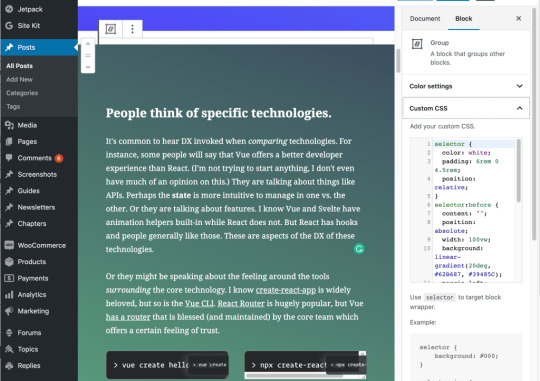

The Block Editor itself is a huge deal for us. That was one of my goals for the year, and we’ve really exceeded how far we’d get with it. I think writing and editing posts in the block editor is a million miles ahead of the old editor.
The hardest challenge was (and still is really) getting the block transforms set up for legacy content. But once you have the power to build and customize blocks, that alone opens up a ton of design possibility within posts that is too big of a pain in the butt and too heavy on technical debt otherwise.
Another door we opened for design possibilities is a classic one: using categories. A sort of freebie you get in WordPress is the ability to create templates for all sorts of things that just sort of automatically work if they are named correctly. So for example I have a filed called category-2019-end-of-year-thoughts.php and that fully gives me control over making landing pages for groups of posts, like our end-of-year thoughts homepage. Not to mention our “Guide Collection” pages which are another way to programmatically build collections of pages.
That’s a lot of tools to do custom work with, and I’m really happy with that. It feels like we’ve given ourselves lots of potential with these tools, and only started taking advantage of it.
Speaking of which, another aspect of custom design we have available is the new book format…
eCommerce
We’re using WooCommerce here on the site now again. I just got done singing the praises of the Block Editor and how useful that is been… WooCommerce is in the same boat. I feel like I’m getting all this powerful functionality with very little effort, at a low cost, and with little technical debt. It makes me very happy to have this site on WordPress and using so much of suite of functionality that offers.
So for one thing, I can sell products with it, and we have products now! Lynn Fisher designed a poster for our CSS Flexbox guide and designed a poster for our CSS Grid guide, which you can now buy and ship anywhere in the world for $25 each. Look, with the Block Editor I can put a block for a poster right here in this post:
CSS Flexbox Poster
Find yourself constantly looking up the properties and values for CSS flexbox? Why not pin this beautiful poster up to the wall of your office so you can just glance over at it?
$25.00
Shop now
Another thing we’re using WooCommerce for is to sell our new book, The Greatest CSS Tricks Vol. I. If we actually made it into a proper eBook format, WooCommerce could absolutely deliver those files digitally to you, but we haven’t done that yet. We’ve take another path, which is publishing the book as chapters here on the site behind a membership paywall we’re calling MVP supporters. The book is just one of the benefits of that.
WooCommerce helps:
Build a membership system and sell memberships. Membership can lock certain pages to members-only as has programmatic hooks I can use for things like removing ads.
Sell subscriptions to those memberships, with recurring billing.
Sell one-off products
And I’m just scratching the surface of course. WooCommerce can do anything eCommerce wise.
Analytics
They are fine. Ha! That’s how much I worry about our general site analytics. I like to check in on them from time to time to make sure we’re not tanking or anything scary, but we never are (knock on wood). We’re in the vicinity of 8m page views a month, and year-over-year traffic is a bit of a dance.

Sponsors
THANK YOU THANK YOU THANK YOU
That’s what I have to say to all our sponsors. We’re so damn lucky to work with a lineup of sponsors that I wholeheartedly endorse as well as literally use their products. We have different sponsors all the time, but these are the biggest and those who have been with us the longest.
Automattic: Thanks for building great software for the WordPress ecosystem. This site is made possible by a heaping helping of that software.
Netlify: Thanks for bringing the Jamstack world to life. I’m also a big fan of this way of building websites, and think that Jamstack should be the foundation for most websites. Beyond that, you’ve redefined modern developer experience.
Flywheel: Thank you for hosting this website, being a high-quality host I can trust and who has been helpful to me countless times. This is what high-quality WordPress hosting looks like.
Frontend Masters: Thank you for being an education partner that does things right and helps me have the best possible answer for people when they are searching a more structured formal education about doing web work: go try Frontend Masters.
If you’re trying to reach front-end developers with your products, that’s literally how I make a living and can help.
My Other Projects
CodePen is no spring chicken either, being over 8 years old itself. I repeat myself a lot with this particular aspect of talking about CodePen: we’ve got a ton of ideas, a ton of work to do, and we can’t wait to show you the CodePen of tomorrow. 2020 for CodePen has been a lot different than the last 2-3 years of CodePen. Some technical choices we’ve made have been starting to pay off. The team is vibing very well and absolutely tearing through work faster than I would have thought possible a few years ago, and we haven’t even unlocked some of the biggest doors yet. I know that’s vague, but we talk in more detail about stuff on CodePen Radio.
ShopTalk, as ever, is going strong. That’s 420 episodes this week, friends. Dave has me convinced that our format as it is, is good. We aren’t an instruction manual. You don’t listen to any particular episode because we’re going to teach you some specific subject that we’ve explicitly listed out. It’s more like water cooler talk between real world developers who develop totally different things in totally different situations, but agree on more than we disagree. We might evolve what ShopTalk show is over time, but this format will live on because there is value in discussion in this format.
Life
My wife Miranda and I are still in Bend, Oregon and our Daughter Ruby is two and a half. She’s taking a nap and I’m looking at the monitor as I type.
We have the virus here like everywhere else. It’s sad to think that we’re this far into it and our local hospital is pleading with people to be careful this holiday weekend because they are very near capacity and can’t take much more. Here’s hoping we can get past this painful period. Stay safe and stay cool, friends, thanks for reading.
I always feel bad when I make design changes away from an actual professional designer’s work. Is the site design better today than Kylie’s original? Uhm probably not (sorry for wrecking it Kylie!), but sometimes I just have an itch to fiddle with things and give things a fresh look. But the biggest driver of change is the evolving needs of the site and my desire to manage things with as little technical debt as possible, and sometimes simplifying design things helps me get there.
The post The Thirteenth Fourth appeared first on CSS-Tricks.
The Thirteenth Fourth published first on https://deskbysnafu.tumblr.com/
0 notes
Text
Can Dogs Eat Tortillas?
Technically, yes, dogs can safely eat tortillas, but there is no nutritional value or benefit to giving your dog tortillas.
Additionally, tortillas are full of unnecessary carbs and calories, so they could cause weight issues if fed in excess.
Can Dogs Eat Corn Tortillas?
Yes, dogs who do not suffer from corn allergies can eat corn tortillas, there is nothing toxic about them.
Corn tortillas are a slightly better choice for your dog than flour tortillas since they usually contain less[1]:
Calories
Carbs
Fat
Sodium
In fact, flour tortillas have 15% more sodium than corn tortillas.
Plus, corn tortillas have more fiber than flour, yet still not enough to make them a good choice for your dog.
But even though corn tortillas are healthier than their flour counterpart, it doesn’t make them the best treat for your pup.
What’s in a Corn Tortilla?
Most corn tortillas are made up of:
Corn Masa Flour
Water
Cellulose Gum – Thickening agent which is common in foods and medications
Propionic Acid – Preservative
Benzoic Acid – Preservative
Phosphoric Acid – Preservative
Guar Gum – Thickening and binding agent
Amylase – A type of enzyme that helps the transformation process of starches to sugar
Though none of the above ingredients pose any threat to your dog’s health, most of the ingredients carry no benefit to your dog’s health either.
Are Corn Tortillas Good for Dogs?
Corn tortillas are neither good nor bad for your dog.
Since they carry no nutritional value, corn tortillas are just fillers and serve no purpose when fed to your pup.
Can Dogs Eat Flour Tortillas?
Yes.
Like corn tortillas, flour tortillas are non-toxic, but also have no benefit either.
Flour tortillas may taste yummy to your dog, but there is no reason your dog needs to eat them.
Waffles also contain flour. Can dogs eat waffles?
What’s in a Flour Tortilla?
Most flour tortillas are made up of:
Enriched Bleached Flour (Flour, Niacin, Reduced Iron, Thiamine Mononitrate, Riboflavin, Folic Acid)
Water
Vegetable Shortening (Interesterified And Hydrogenated Soybean Oils)
Salt
Sugar
Baking Soda
Sodium Acid Pyrophosphate – Common additive in processed foods
Distilled Monoglycerides – Commonly used in baking for improving product quality, crumb softening, extends shelf life, fat reduction[2]
Enzymes – Biological molecules that help chemical reactions[3]
Fumaric Acid – Additive for flavor
Calcium Propionate – Preservative commonly used in bread
Sorbic Acid – Preservative
Are Flour Tortillas Good for Dogs?
As you can tell from the ingredients listed in the above section, there is nothing of nutritional benefit in flour tortillas.
They lack any significant amount of healthy vitamins and minerals.
If you want to feed your dog nachos then go easy on the cheese!
What About Tortilla Chips?
Tortilla chips will not kill your dog; there is nothing poisonous about them.
However, they are worse than both corn and flour tortillas. Not only do they lack any health benefits, but they are also deep-fried and often high in sodium.
Plus, some tortilla chips have added seasonings such as garlic and onion, which are definitely not a good choice for dogs.
So though non-toxic, tortilla chips can add to other health issues such as obesity.
Possible Dangers of Tortillas
Though tortillas are technically not dangerous for your dog, there are a few negative effects of feeding your dog tortillas or tortilla chips, including:
Obesity
Because tortillas are higher and carbs, they can cause your dog to gain weight quickly.
And obesity is the cause of several health risks such as cancer, diabetes, and increased joint pain.
High Sodium Content
Though some sodium is required in a healthy dog’s diet, higher levels of sodium in your dog’s food may cause further complications if they suffer from liver, kidney, or heart disease
Allergies and Food Sensitivities
Dogs who suffer from food allergies and sensitivities should avoid foods containing gluten and grains.
Digestive Issues
Since grains are more difficult for dogs to process than humans, dogs who suffer from digestive issues should avoid tortillas
What to Do if Your Dog Eats a Tortilla
One tortilla or one chip isn’t going to kill or harm your dog.
Even if they have an allergy, food sensitivity, or digestive issues, your pup may experience some discomfort in the form of GI upset or itchiness, but that would be all.
However, if your dog eats a bag of tortillas or a bag of chips, you will want to contact your vet.
Dogs who consume excessive amounts of food may experience considerable discomfort, but more serious issues could arise as well.
Overeating can also be extremely dangerous since it can cause bloat[4], a condition in which a dog’s stomach twists.
Unfortunately, if a dog isn’t brought in for medical help immediately, bloat is often fatal.
“Whatcha got there? Is it for me?”
Why You Shouldn’t Feed Tortillas to your Dog
Feeding foods such as tortillas and tortilla chips can have more significant issues than the food itself.
Feeding human food to your dog can cause behavioral problems such as:
Begging
Counter Surfing
Begging is a bad behavior many of us have allowed and often encouraged.
However, many of us also become irritated when our dog begs from friends and family who are visiting. Your dog doesn’t know that begging is something that should only be done when company isn’t over.
Do your best to set your dog up for success and don’t feed them from your plate.
After dogs learn that mom and dad keep the salty, crunchy snack known as tortilla chips on the counter, they may be inclined to check things out for themselves.
Once a dog realizes and benefits from counter surfing, i.e., getting a yummy snack, they are more motivated to keep up the bad behavior.
Though tortillas cannot be blamed solely for these behaviors, feeding human food can create little monsters out of our furry angels.
Conclusion
In addition to lacking any nutritional value, tortillas can be difficult for some dogs to digest due to their high grain content.
And if your dog has food sensitivities or allergies, they are likely allergic to grains and gluten, making tortillas definitely off-limits.
I am always surprised at how much time dog parents, myself included, spend on finding the right healthy dog food, yet turn around and offer a processed snack like tortillas to our dogs.
If we looked at a bag of dog treats and saw the ingredient list for tortillas or tortilla chips, we would never buy them. (I am not judging. I too have been guilty of sharing a snack or two with my pups.)
Also, there are so many healthier treat options for your dog, such as most vegetables and some fruits like:
Green beans
Carrots
Cucumbers
Zucchini – One of Calvin’s favorite treats
Apples
Berries
Resources
https://www.healthline.com/nutrition/corn-vs-flour-tortilla#4
https://www.dupontnutritionandbiosciences.com/products/dimodan.html
https://www.livescience.com/45145-how-do-enzymes-work.html
https://www.greenbrier-emergency.com/bloat-torsion-dogs/
from Central Park Paws https://www.centralparkpaws.net/faqs/can-dogs-eat-tortillas/?utm_source=rss&utm_medium=rss&utm_campaign=can-dogs-eat-tortillas
0 notes
Text
Journal - Unemployed Architects: What to Do Right Now
Architects: Showcase your next project through Architizer and sign up for our inspirational newsletter.
It’s becoming clear that the spike in unemployment caused by Covid-19 will likely have long-lasting consequences. While a shrinking economy doesn’t completely erase opportunity, for unemployed architects who have either lost their jobs or are just finishing school, the possibility of finding a full-time position eventually doesn’t solve a more immediate problem: what to do right now.
For unemployed architects in that painful situation, this article surveys some immediate-action strategies to help make a living while also maintaining a designer’s skill set for future work. Tactics include assembling a patchwork of part-time engagements that utilize architectural skills, expanding a job search by pursuing remote work in distant locations, and starting to build a framework for your own practice.
When faced with an involuntary career break, it’s helpful to remember that finding your next long-term position is primarily a matter of time. Thus, the most important thing you can do is buy yourself time to ride out a prolonged job search. This means doing anything you can to support yourself that also maintains, or allows you the time to maintain, hard-earned architectural skills. Luckily, architectural skills can be applicable to a wide range of short-term, digitally remote freelance work.
Architectural rendering by xrender listed on Fiverr Pro marketplace
Part-Time Gigs
One of the most obvious applications is visualization. There’s many ways to go solo in this area, from listing your services on a freelance marketplace to soliciting your network of employed architects to see if their firm needs ad hoc renderings with a quick turnaround. If you’re inclined to seek a more permanent arrangement, you can quickly expand the number of full-time positions you’re searching for by including visual media beyond architecture, such as visual effects producers for film, television, or video games.
Another profession with a perennial need for one-off architectural services is real estate. Drafting simple floor plans for a leasing agency, for example, may not be glamorous, but can be a short-term way to get paid for drawing buildings. This can also be a good way to become acquainted with private developers, who may be looking to hire an in-house architect to be their advocate on large projects, or could even become clients for your own practice.
The Imprint by MVRDV, façade by KEIM
It’s also worth looking toward professions architects frequently hire as subconsultants. Façade design, parametric modelling, and graphic design, for example, are just some of the many fields packed with single-focus firms specializing in skills architects often use every day. Looking for part-time work in one of these disciplines can be a way to hone particular skills for a short period, or could even lead an architectural career in a new and interesting direction.
A slew of relevant stop-gap working opportunities for unemployed architects, particularly recent graduates, can also be found in higher education and cultural institutions. Academic research, curatorial fellowships, and similar positions that don’t require full-time teaching are less susceptible to the sort of volatility Covid-19 has wrought on the economy. Such positions can offer worthwhile, paid experience that can be gained parallel to a full-time job search.
Remote Working
Not all unemployed architects, of course, will be able to take advantage of adjacent professions, but it’s clear by now that widespread remote working is here to stay, at least in some form, for quite some time. So a simple way to expand the pool of jobs available to out-of-work architects is to look for them in firms based outside one’s immediate city or region.
This should be noted with the caveat that it’s currently unclear how willing a wide swath of architecture firms may be to hire remote staff working from far-flung locations. Many factors influence a business’ attitude towards this, from local professional regulations to payroll and tax filing issues. However, a number of tech-savvy firms have long embraced remote working, and it’s highly likely that the number of architecture firms utilizing a full-time remote workforce increases substantially after the current crisis subsides.
Image by Elena Borisova from Pixabay
Starting Your Own Firm
A final path unemployed architects might find worth pursuing is to start their own firm. This is especially true for early to mid-career designers, who probably have a modest network and enough experience to facilitate a successful project but aren’t as familiar with the process designers go through to get clients.
Taking this approach obviously doesn’t pay until you get a client, so it’s probably not a priority for the recently unemployed, but even unsuccessfully pursuing your own projects in between part-time work and searching a for a full-time job can be a truly valuable experience. Forcing yourself to learn first-hand what it takes to win an architectural commission might open all sorts of doors if you just try, and at the very least will make you more valuable to future employers.
Regardless what strategy, or combination of strategies, someone takes to get through a bout of unemployment, it’s necessary to look for new opportunities in ways you might not have considered before. By opening yourself to the idea of following a completely different career direction than the one you’re used to, you may unintentionally find a new way to earn a living, making your skills, experience, and general disposition more resilient in the process.
Architects: Showcase your next project through Architizer and sign up for our inspirational newsletter. Top image by niekverlaan from Pixabay
The post Unemployed Architects: What to Do Right Now appeared first on Journal.
from Journal https://architizer.com/blog/practice/tools/unemployed-architects-what-to-do-right-now/ Originally published on ARCHITIZER RSS Feed: https://architizer.com/blog
#Journal#architect#architecture#architects#architectural#design#designer#designers#building#buildings
0 notes
Link
This was a weird year for food. Scientists grew (surprisingly good) plant-based meat products in labs, some people decided to eat nothing but meat, other people barely ate anything at all. Seltzer had a comeback, researchers developed wearable tech that could tell you when you needed to hydrate, and an Outside editor experimented with drinking an entire gallon of water a day. Amid the madness, a few ideas drifted to the top, ones that were evidence based and reasonable and could actually help you live a little more healthfully. Read on to learn which trends you should forget about in the new year and the few that you should carry with you.
Skip: Celery Juice
In May, wellness guru Anthony William published a book claiming that daily celery juice could detox your body and provide all kinds of dubious health benefits, like flushing toxins from your brain and curing asthma, addiction, and Lyme disease. It caught on in certain circles, but none of his claims were backed by scientific evidence.
The idea that any food can detox your body is garbage. As Robin Foroutan, a registered dietitian and spokesperson for the Academy of Nutrition and Dietetics, previously told Outside, “The body detoxifies on its own, or we would be dead in days.” And while drinking celery juice won’t do any harm, it likely won’t do any good either. The closest thing to an endorsement of the stuff is a 2013 trial during which 30 adults with high blood pressure took celery-extract supplements (pills, not juice) for six weeks and reported slightly lower blood pressure at the end of the trial. Caveats? The extract was far more concentrated than juice, there was no control group, and the lead researchers worked for the company that made the celery extract.
Keep: Fermented Foods for Gut Health
The gut microbiome is a relatively new area of study, but there’s promising evidence that the unique makeup of healthy bacteria that exists in each of our bodies is a key factor in overall health. A 2019 review found that ingesting both probiotics (bacteria) and prebiotics (a type of dietary fiber that feeds bacteria) can support a healthy microbiome.
But getting probiotics and prebiotics in supplement form probably isn’t your best bet. “Currently, there’s no evidence that long-term, continued consumption of supplemental probiotics maintains wellness,” said Jack Gilbert, a researcher at the University of Chicago, in a previous interview. Instead, it’s best to get probiotics through fermented foods. Prebiotics, on the other hand, can be found in fruits, vegetables, beans, and other high-fiber foods.
Skip: Extreme Intermittent Fasting
Intermittent fasting (IF) is a time-restricted diet during which you only eat for a set period of time each day. It’s more of an umbrella term than a rigid protocol: one popular approach is to eat during an eight-hour window each day; another is to eat normally except for one or two days of extremely low-calorie intake per week. But this year, the more extreme one-meal-a-day (OMAD) approach gained some traction. Experts warn against OMAD for a variety of reasons. One small 2007 randomized control trial of 21 adults over eight weeks found that eating one meal a day resulted in lower body-fat percentage but higher hunger levels, blood pressure, and cholesterol levels compared to subjects who ate three meals a day. And that doesn’t take into account the emotional and social toll of such an extreme diet.
The benefits of any kind of IF are still up in the air, but if you’re curious about it, stick to a gentler approach. Eating within a 12-hour window—from 8 A.M. to 8 P.M., for example—will likely deliver many of the same potential benefits, nutrition scientist Stacy Sims previously told Outside.
Keep: Intuitive Eating
Intuitive eating has been around since 1995, when registered dietitians Elyse Reich and Evelyn Tribole published a popular book on the topic. But it gained mainstream traction this year: we wrote about it in May, The New York Times published an op-ed in June presenting it as an antidote to toxic wellness culture, and dozens of nutritionists encouraged their clients (online and off) to start eating a little more freely.
This relaxed approach to food is guided by ten principles, like “honor your health,” “respect your body,” and “challenge the food police,” and it’s all about tuning in to your own preferences and needs and tuning out messages about what you should or shouldn’t eat. While more research is needed, there’s evidence that intuitive eating is good for both mental and physical health, and it might even be associated with a more nutritious diet overall.
Skip: Keto
Going keto means getting 75 to 80 percent of your calories from fat, 15 to 20 percent from protein, and less than 5 percent from carbs. It’s also one of the most popular extreme diets out there at the moment. There is significant evidence that ketosis—a metabolic state wherein the body starts using fat as a primary fuel source due to a lack of carbs—helps reduce seizures in people with epilepsy. But there aren’t many evidence-backed benefits beyond that.
Amy Gorin, a registered dietitian in the New York City area, explained that while short-term weight loss often happens on the keto diet, it generally isn’t sustainable. Maintaining ketosis is difficult, since going over your carb allotment just once can trigger your body to start using glucose (carbs) as fuel again instead of fat. And many people gain back any weight they lost once they begin to eat regularly, Gorin said. Low-carb diets aren’t an inherently better choice than any other calorie-restricted diet, but if you think they might be right for you, Gorin suggests a more moderate approach than keto.
Keep: Plant-Based Eating
Plant-based burgers blew up this year. You can now get an Impossible Whopper at Burger King or an Impossible Slider from White Castle, both engineered to look, cook, and taste like meat. If that isn’t proof enough that plant-based foods are here to stay, consider the fact that, according to one report, the global plant-based “meat” market was valued at $10 billion in 2018 and is forecasted to hit $31 billion by 2026.
These new plant-based meats aren’t intended to be a healthier version of beef—the nutritional profile is actually quite similar; instead, they’re meant to be a more environmentally friendly way to eat what tastes like meat, explained Jonathan Valdez, a registered dietitian in New York.
The research on the health benefits of limiting your consumption of animal products is still evolving, but it’s promising. A 2019 review of several randomized control trials found that vegan and vegetarian diets are linked to improved metabolic health. You don’t have to go full-on vegetarian, according to Shivam Joshi, an internal-medicine physician at the New York University School of Medicine. Even swapping out a handful of animal-based meals every week will benefit you.
Skip: Adaptogens
Using plants for healing purposes is an ancient practice, but Western wellness culture really dug its teeth into the idea this year. Adaptogens, defined by scientists as plant-based substances thought to enhance the body’s resistance to various kinds of physical and mental stress, are showing up all over: keep an eye out for ashwagandha on your popcorn or maca in your smoothie bowl.
Any wellness claims that brands make about these ingredients are hopeful guesses at best. Ashwagandha’s many purported benefits (pain relief, diabetes management, and anti-aging, among others) have yet to be consistently proven by research. And although some people believe that maca can improve reproductive health and fight cancer, these claims also have no real evidence behind them. That said, adaptogens are unlikely to hurt you, so if you don’t mind the taste (or the cost), keep on eating them. But don’t claim that they’re magic.
Keep: Seaweed
Sushi has been popular for years, and crispy seaweed snacks are available everywhere from Whole Foods to Trader Joe’s. Still, most of us don’t yet think of seaweed as a comparable alternative to green vegetables like kale and spinach. An April New York Times article explained that seaweed is a much lower-impact crop, since it doesn’t use any land, fresh water, or fertilizers. In fact, it can even help the environment: kelp has been shown to drastically improve water quality. Like other green vegetables, seaweed is packed with micronutrients, but it’s not your typical green. The rich umami flavor can add depth to many dishes.
via Outside Magazine: Nutrition
0 notes
Text
Top 15 Interesting Marijuana Facts By: Fallon from @canna_queens_og
Interesting Marijuana Facts That Will Blow Your Mind
How much do you know about marijuana? With the recent legalization of cannabis in Canada, it seems to now be the topic of conversation all around the country. Everywhere we turn in Canada, marijuana talks are all around. From a new mail order marijuana online dispensary opening up, to Instagram accounts or someone looking to buy bulk weed online. Forums are filling up with chats about budget buds, cheap weed and people making weed related jokes at the office.
With cannabis talks at the tip of everyone’s tongue, we thought it would be a great idea to share some super interesting marijuana facts that are bound to stun you. This way, our readers can learn something new and have some fascinating, weed related conversation-starters. Here are our top fifteen and just wait until you read the last one.
01 Weed+Beer=Family!
Yes you read that right! Marijuana fact number one Hemp and hops are cousins. Beers hops and the cannabis plants are a part of the Cannabaceae family and both plants bear similar terpenes such as myrcene and beta-pinene. Unlike cannabis, hops does not contain any cannabinoids.
02 George Washington Grew Dope
George Washington grew his own marijuana plants at Mount Vernon and referred to them as hemp plants. Researchers found notes were found about separating the male from the female plant, blossoming hemp and more in his old letters.
03 Not Growing Pot Was Against The Law In 1619
The Jamestown Colony, one of the first English settlements in America, passed a legislation imposing all settlers to grow marijuana around 1619. The law was not to encourage people but to force people to grow the plant. Hemp was used to make so many staple items such as rope, ship sail, and fabric therefore it had a high importance for themselves but also to bring in income from others. Not growing cannabis was against the law in 1619 and now, four hundred years later, look at us.
04 Marijuana available at the pharmacy.
Medicinal marijuana was easily and readily accessible in local general stores and pharmacies between the years of 1850 to 1942. It was listed as a medicine to be used to help with nausea, labour pain, and rheumatism.
via GIPHY
05 Canvas=Cannabis
The word canvas was derived from the word cannabis as historically most canvasses were made from hemp. Today you can find canvases made from many different materials but it is rare and considered a novelty if it is made from hemp. It is no surprise that that anything art related can come from the plant as we all know that the right strain can really get the creative juices flowing.
06 Cannabis is legal in North Korea.
The plant grows wildly in North Korea making it so the government does not even consider it a drug. North Koreans are allowed to freely enjoy consumption of the magical plant in both private and public areas. At one point marijuana or what they call “yoksam” was sold abroad as a way to earn foreign currencies.
07 Weed grows like weeds in Bhutan!
Just like North Korea, the plant is so common, it grows everywhere! The people of Bhutan see it as a nuisance, just as we view dandelions here in Canada. You can find them growing between cracks in the road and in forests. In Bhutan, hardly anyone smokes the plant and it is more common than regular green grass. Roadside cannabis plants are used to feed livestock. Pigs are regularly fed the plants to increase their appetite and fatten them up.
08 India has marijuana milkshakes
It’s called Bhang and everyone is drinking it. The Indian subcontinent has always been a big fan of ganja and in 1894 their government even declared the plant harmless. However the British came along and changed everything as they thought the plant was making the Indian citizens crazy. The use of cannabis in India can be traced back to many years BCE and you can find literatures referencing other intoxicating drinks that contain marijuana.
09 Mexico gave us the word marijuana.
The name marijuana was derived from Mexican slang. The two names Mary and Jane were common Mexican military slang for women working in brothels. From Mary and Jane, it became Maryjane and then to marijuana. Not to have anything to do with brothels but for the beautiful plant.
10 Rastas are allowed to smoke weed in Italy.
Although the use of the plant is still very much illegal in Italy, Rastafarians are allowed to possess and smoke marijuana. Since consuming cannabis is a sacrament to the Rastafari religion, this gives them the right to legally do so in Italy. Grazie Italia!
11 Bob Marley buried with bud!
There are many people that would like to be buried with the items they love and cherish the most. This was the case for Bob Marley and those who loved him most made sure this happened his request was granted. He was laid to rest in his grave with his red Gibson Les Paul guitar, his bible and some bud.
12 Dope was the first item to ever be sold over the Internet
Multiple resources claim that the first ever purchase on the internet was a nice bag of weed. Students from Stanford used Arpanet which was the first early stages of the Internet and purchased weed from one of their rival schools MIT.
13 More dispensaries than Starbucks
Right now in Colorado there are more recreational cannabis dispensaries than Starbucks. There is a ratio of 3:1 dispensary:Starbucks. These dispensaries should just start selling coffee or Starbucks should start selling weed.
14 You cannot overdose with cannabis.
Perhaps the best marijuana fact for those who are trippin’ balls. History shows that there is not one record of a death caused by use of marijuana. One would have to smoke over 600 kgs of weed in less than fifteen minutes to die from it, that is an incredible amount of weed.
via GIPHY
15 Tupac was smoked.
WHAT??? Yes you read right, Tupac Shakur was smoked! Forget about pouring out your fourty for your homies, Pac’s boys took it to a whole other level. They took some of his ashes, sprinkled it like it was kief on top of the bud in their joint and smoked it. In his song Black Jesus he does say, “last wishes, n*%%@$ smoke my ashes” and well his homies took that to heart and made his last wishes come true.
Conclusion
There it is, fifteen interesting marijuana facts that you probably didn’t know and can now tell your friends about. Don’t forget to tell them where you read this because here at Weed-Deals, not only can you come to us to buy weed online with stress free and fast delivery, but we also want you to enhance your experience by giving you a good read.
The post Top 15 Interesting Marijuana Facts By: Fallon from @canna_queens_og appeared first on Weed Deals.
source https://www.weed-deals.ca/top-15-interesting-marijuana-facts/?utm_source=rss&utm_medium=rss&utm_campaign=top-15-interesting-marijuana-facts source https://weeddealsca.tumblr.com/post/184408488722
0 notes
Link
How to use Text To Speech inside RecyclerView in Android
What is TTS (Text To Speech)?
TSS or Text To Speech is library provided by Android, which is used to convert any word into voice. This means it can speak any word or phrase provided to this library.
So if you are creating Android Application which require some speaking words then you don’t need to record voice and play inside your application. You can simply pass your words to this library and it will do rest of the things.
We will use android.speech.tts.TextToSpeech library to convert our Strings into voice.
Overview to TTS
First step is to create instance of TextToSpeech.
Pass context to TextToSpeech’s contructor and Callback (which will be called when TextToSpeech will ready).
There is 3rd optional parameter which is “engine” which is used to pass custom TextToSpeech engine. (eg. Samsung TTS etc.).
After creating instance call speak() function from instance and it will speak the provided string.
You can also specify language of your text to TextToSpeech library.
Example Project:
TextToSpeech inside RecyclerView:
Code of MainActivity.kt
Code of activity_main.xml
Code of SpeechAdapter.kt
Code of adapter_item_speech.xml
Full Source Code
SpeechTextRecyclerView on Github
Star this github repository and Share with your friends as well.
via Learn Pain Less's RSS Feed
0 notes